Nissan Leaf
| Nissan Leaf | |
|---|---|
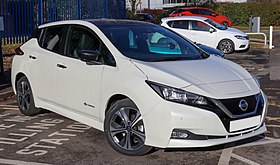 | |
| Overview | |
| Manufacturer | Nissan |
| Production | 2010–present |
| Body and chassis | |
| Class | Compact car / Small family car (C) |
| Body style | 5-door hatchback |
| Layout | Front-motor, front-wheel-drive |
The Nissan Leaf (Japanese: 日産リーフ) is a compact five-door hatchback electric car manufactured by Nissan, introduced in Japan and the United States in December 2010, and now in its second generation. The U.S. Environmental Protection Agency (EPA) official range for the 2018 model year Leaf is 243 km (151 miles) on a full battery charge.
Among other awards and recognition, the Nissan Leaf has won the 2010 Green Car Vision Award, the 2011 European Car of the Year, the 2011 World Car of the Year, and the 2011–2012 Car of the Year Japan.
Since inception, global sales totaled over 400,000 Leafs by March 2019, making the Leaf the world's all-time best-selling highway-capable electric car.[1] The United States is the world's largest Nissan Leaf market, with 126,747 sold through October 2018; followed by Japan with 100,000 units by April 2018; and Europe with 100,000 by June 2018. The European market was led by Norway with 33,156 new units registered by the end of October 2018. The Nissan Leaf was the world's best-selling plug-in electric car in 2013, 2014, and 2016.
Contents
- 1 Development history
- 2 First generation (2010–2017)
- 3 Second generation (from 2017)
- 4 Markets and sales
- 5 Reported problems
- 6 Related cars
- 7 Motorsport
- 8 Reception
- 9 See also
- 10 References
- 11 External links
Development history[edit]
Nissan introduced its first battery electric vehicle, the Nissan Altra, at the Los Angeles International Auto Show on 29 December 1997.[2] The Altra was produced between 1998 and 2002. Only about 200 Altras were ever produced, and it was mainly used as a "fleet vehicle" for companies such as electric utilities.[3][4] Nissan also developed the Nissan Hypermini and ran a demonstration program for it. The car sold in limited numbers to supply government and corporate fleets in Japan between 1999 and 2001.[5] A small fleet of Hyperminis was also field-tested in several cities in California between 2001 and 2005.[6]
In 2009, Nissan unveiled the EV-11 prototype electric car. It was based on the Nissan Tiida (Versa in North America), but with the conventional gasoline engine replaced with an all-electric drivetrain, and included an 80 kW (110 hp)/280 N⋅m (210 lb⋅ft) electric motor, 24 kWh lithium-ion battery pack rated to have a range of 175 km (109 miles) on the United States Environmental Protection Agency's LA-4 or "city" driving cycle, navigation system, and remote control and monitoring via a cellphone connection through Nissan's secure data center to the car.[7] The technology in the EV-11 was previously developed and tested in the EV-01 and EV-02 test cars, built with an all-electric powertrain that used the Nissan Cube (Z11) as a development mule.[8][9] The EV-11 prototype was on display 26 July 2009.[7] A week later, on 2 August 2009, Nissan unveiled its production version at its Yokohama headquarters and committed to begin retail sales in both the North American market and in Japan at end of 2010.[10][11]
First generation (2010–2017)[edit]
| Nissan Leaf (ZE0) | |
|---|---|
_hatchback_(2018-11-02)_01.jpg) | |
| Overview | |
| Manufacturer | Nissan |
| Also called | Venucia e30 (China) |
| Production | 2010–2017 |
| Assembly | Japan: Oppama Plant, Yokosuka, Kanagawa, Japan United States: Smyrna, Tennessee United Kingdom: Sunderland (NMUK) |
| Body and chassis | |
| Platform | Nissan EV platform |
| Powertrain | |
| Electric motor | 80 kW (110 hp), 280 N⋅m (210 ft⋅lb) synchronous motor[12] |
| Transmission | Single speed constant ratio (7.94:1)[13] |
| Battery | MY 2011-15 and MY 2016 S trim 24 kWh lithium-ion battery MY 2016 (SL and SV trims) 30 kWh lithium-ion battery[14] |
| Range | MY 2011/12 117 km (73 miles) EPA 175 km (109 miles) NEDC MY 2013 121 km (75 miles) EPA[15] 200 km (120 miles) NEDC[16] MY 2014/15 135 km (84 miles) EPA[14] MY 2016 with 24 kWh battery 135 km (84 miles) EPA[14] with 30 kWh battery 172 km (107 miles) EPA[14] |
| Plug-in charging | 3.6 kW (3.3 kW output) and optional 6.6 kW (6.0 kW output) 240 V AC[17] on SAE J1772-2009 inlet, max 44 kW 480 V DC on CHAdeMO inlet,[18] adapters for domestic AC sockets (110–240 V) |
| Dimensions | |
| Wheelbase | 2,700 mm (106.3 in)[19] |
| Length | 4,445 mm (175.0 in)[19] |
| Width | 1,770 mm (69.7 in)[19] |
| Height | 1,550 mm (61.0 in)[19] |
| Curb weight | MY 2011/12 1,521 kg (3,354 lb)[20] MY 2013 1,493 kg (3,291 lb)[21] MY 2017 1,500-1,538 kg (3,307-3,391 lb) |
Design[edit]
Nissan sought to make the Leaf appealing to mainstream drivers by giving it a familiar five-door hatchback design.[22] The body has a sharp V-shape design with large, up slanting LED headlights that split and redirect airflow away from the door mirrors, and the bottom of the car has aerodynamic panelling.[23] According to Nissan, the 2011 Leaf has a drag coefficient of Cd=0.29 and the 2013 model year has a drag coefficient Cd=0.28, but Car and Driver magazine measured a 2012 Leaf at Cd=0.32.[24][25] The Leaf's design locates the battery, the heaviest part of any EV, below the seats and rear foot space, keeping the center of gravity as low as possible and giving the car better structural rigidity than a conventional five-door hatchback.[20][26][27]
Powertrain[edit]
The Leaf is powered by a synchronous electric motor with 80 kW (110 hp) and 280 N⋅m (210 ft⋅lb) driving the front wheels, with energy supplied by a 24 kWh lithium ion battery pack rated to deliver up to 90 kW (120 hp).[12][28] The 2011/12 model Leaf has a top speed of over 150 km/h (93 mph) and an unofficial 0 to 97 km/h (0 to 60 mph) time of 9.9 seconds.[20]
Battery[edit]
The 24 kWh electric vehicle battery consists of air-cooled, stacked laminated lithium ion manganese oxide batteries manufactured by Automotive Energy Supply Corporation (AESC).[29][30][31][32] The 192 cells are arranged into 48 modules of 4 cells each.[33][34][26]
In addition to the main battery, the Leaf also has an auxiliary 12-volt lead–acid battery that provides power to the car computer systems and accessories.[35] The small solar panel on the Leaf rear spoiler helps to charge this accessory battery.[36] (In United States models only comes with SL trim.[37])
Battery life and degradation[edit]
Nissan said the battery will gradually lose capacity over time, but it expects a useful life of over ten years under normal use.[38] The battery pack is expected to retain 70–80% of its capacity after 10 years but its actual lifespan depends on how often DC fast charging is used, driving patterns, and environmental factors.[32][38] In March 2018, a statistical study compared reported battery decline in 30 kWh Leafs and 24 kWh Leafs, with 30 kWh models exhibiting the same battery capacity as 24 kWh cars within 3.5 years, albeit with probable accelerated battery decline in 30 kWh models.[39] The 2011/12 Leaf's battery was initially guaranteed by Nissan for eight years or 160,000 km (100,000 miles)[40][41] Nissan stated in 2015 that until then only 0.01% of batteries, produced since 2010, had to be replaced because of failures or problems and then only because of externally inflicted damage. Some vehicles have already covered more than 200,000 km (120,000 miles) with no battery problems.[42] In April 2016, Nissan estimated that fewer than 5 batteries are replaced per year worldwide; about 0.012% of all Leafs since introduction.
As a result of the controversy regarding several U.S. owners reporting premature loss of battery capacity in places with hot climate, Nissan USA announced in January 2012, that it will offer an extended battery warranty on the 2013 model year Leaf which includes 2011 and 2012 model years as well.[43] The 2013 Leaf is covered by a "State Of Health" clause which covers gradual capacity loss. This provision allows for the battery pack to either be repaired or replaced if the battery life reduces quicker than anticipated over the eight years warranty period.[44]
- Battery replacement program
Beginning in 2014, Leaf owners could sign up to pay a monthly fee, and receive a new battery pack with the latest available technology that is compatible with their vehicle. The replacement battery has a full 12 bars (100%) of capacity. Nissan said the replacement pack will maintain at least nine bars (70% capacity) or more capacity for the time that they own their car and make monthly payments.[45] Leaf owners could also buy a new battery at a discount.[46]
In June 2014, the cost of a replacement battery with new heat-tolerant chemistry was $5500.[47][48] In May 2018, remanufactured batteries were offered in Japan for under $3000. Later in 2018, in the U.S. market, the cost of a new replacement battery was quietly raised to $8500.[49]
Range and fuel economy[edit]
With an efficient electric powertrain, the Leaf is generally cheaper to operate than traditional gasoline and hybrid cars.[50][51] However, since the Leaf costs significantly more than similar gasoline-powered vehicles, it may take a long time for the fuel savings to cancel out the increased initial cost, even after tax incentives.[52][53][54]
2011/12 model year[edit]
The United States Environmental Protection Agency official range is 117 km (73 miles), much less than the 160 km (100 miles) quoted by Nissan.[55][56][57][58] The Leaf has a range of 175 km (109 miles) on the New European Driving Cycle (NEDC).[59]
Based on third-party test drives carried out in the U.S., reviewers have found that the range available from a single charge can vary up to 40% in real-world situations; reports vary from about 100 km (62 miles) to almost 222 km (138 miles) depending on driving style, load, traffic conditions, weather (i.e., wind, atmospheric density), and accessory use.[60][61]
Under its five-cycle testing, the US Environmental Protection Agency found the 2011 model Leaf's energy consumption to be 21.2 kWh/100 km (34 kWh/100 miles) and rated the Leaf combined fuel economy at 99 miles per gallon gasoline equivalent – MPGe – (2.4 L/100 km), with an equivalent 106 mpg‑US (2.2 L/100 km; 127 mpg‑imp) in city driving and 92 mpg‑US (2.6 L/100 km; 110 mpg‑imp) on highways.[55][56][62]
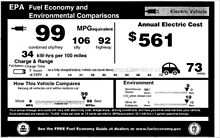
2013 model year[edit]
According to Nissan, the U.S. 2013 model year Leaf has extended range due to a more efficient heating system, better regenerative braking, weight reduction, and improved aerodynamics.[63][64] The EPA rating is 121 km (75 miles) from 117 km (73 miles) in the previous models due to a technicality in the rating system.[15]
Nissan explained that these ratings are not comparable because 2012 and earlier ratings assumed the battery was charged to 100%, but 2013 ratings are an average of the car's two charging modes, Long-Distance Mode, which charges the battery to 100%, and Long-Life Mode, which charges the battery to only 80%. Range in Long-Distance Mode is estimated at 135 km (84 miles).[15][64] The 2013 European version has a certified range of 200 km (120 miles) under the NEDC.[16]
For the 2013 model year Leaf, Nissan achieved a 15% improvement of its EPA's fuel economy combined ratings.[65] According to the EPA, the 2013 Leaf improved its energy consumption to 115 mpg‑e (30 kW⋅h/100 mi; 18.6 kW⋅h/100 km), giving 129 mpg‑e (27 kW⋅h/100 mi; 16.6 kW⋅h/100 km) in city driving and 102 mpg‑e (34 kW⋅h/100 mi; 21 kW⋅h/100 km) on highways.[66]
2014/15 model year[edit]
The official EPA range for the 2014 and 2015 model year Leaf, increased from 121 to 135 km (75 to 84 miles).[67] The difference in range is due to a technicality, as Nissan decided to eliminate the EPA blended range rating, which was an average of the 80% charge range and the 100% charge range. For the 2014 model year, only the 100% charge range figure applies.[68]
According to the EPA, the 2014 and 2015 model year Leafs have an energy consumption of 30 kWh/100 miles, for a combined city/highway rating of 114 mpg‑e (30 kW⋅h/100 mi; 18.7 kW⋅h/100 km); 126 MPGe (27.3 kW⋅h/100 mi; 17.0 kW⋅h/100 km) city and 101 MPGe (34.0 kW⋅h/100 mi; 21.2 kW⋅h/100 km) highway.[14]
2016 model year[edit]
Nissan added more battery capacity which increased the range of the car on a full charge. For the 2016 model year, a larger 30 kWh battery was included on the SL and SV trims, and the S trim initially kept the smaller 24 kWh battery found in earlier Leafs.[69] However, midway through the 2016 model year, Nissan changed the battery in the base Leaf S model from 24 kWh to 30 kWh.[70]
The official EPA range for the 2016 Leaf with the 30 kWh battery is 172 km (107 miles), while the range for the 24 kWh leaf stayed at 135 km (84 miles).[14][better source needed][71][72]
The 2016 Leaf with the smaller 24 kWh battery has the same ratings and energy consumption as the 2014/15 models, while the trims with the larger 30 kWh has the same energy consumption of 30 kWh/100 miles, but was rated 112 MPGe (30.7 kW⋅h/100 mi; 19.1 kW⋅h/100 km) for combined city/highway; 124 MPGe (27.7 kW⋅h/100 mi; 17.2 kW⋅h/100 km) city and 101 MPGe (34.0 kW⋅h/100 mi; 21.2 kW⋅h/100 km) highway.[14]
2019 model year
The 2019 model year's S, SV, and SL trims have a 40 kWh battery with an EPA range of up to 240 km (150 miles). The S Plus, SV Plus and SL Plus models have a 62 kWh battery with an EPA range of up to 364 km (226 miles) miles. The energy consumption for the 40 kWh models is 112 MPGe combined city/highway; 124 MPGe city and 99 MPGe highway.[73]
The estimated Level 2 charging times from fully discharged to 100% are 8 hours for the 40 kWh model and 11.5 hours for the 62 kWh model. The estimated Level 3 DC Quick Charge (50 kW) charging times from fully discharged to 80% are 40 minutes for the 40 kWh model and 60 minutes for the 62 kWh model.[74]
Environmental footprint[edit]
In February 2014, the Automotive Science Group (ASG) published the result of a study conducted to assess the life-cycle of over 1,300 automobiles across nine categories sold in North America. The study found that among advanced automotive technologies, the Nissan Leaf holds the smallest life-cycle environmental footprint of any model year 2014 automobile available in the North American market with minimum four-person occupancy. The study concluded that the increased environmental impacts of manufacturing the battery electric technology is more than offset with increased environmental performance during operational life. For the assessment, the study used the average electricity mix of the U.S. grid in 2014.[75][76]
In December 2014, Nissan announced that Leaf owners have accumulated together 1 billion kilometers (625 million miles) driven. This amount of electric miles translates into avoiding 180 million kilograms of CO
2 emissions by driving an electric car in comparison to travelling with a gasoline-powered car.[77] In December 2016, Nissan reported that Leaf owners worldwide achieved the milestone of 3 billion kilometers (1.9 billion miles) driven collectively through November 2016, saving nearly 500 million kilograms of CO
2 emissions.[78]
Recharging[edit]
Charging ports vary among models. Before late 2016, the Nissan Leaf S and SV came with a standard SAE J1772 connector for level 1 and 2 charging (120/220 volts AC)[79] while the SV trim line came with an additional CHAdeMO port for DC fast charging.[80][81] Beginning in late 2016, all three models (S, SV, and SL) came equipped with both charging receptacles.[70]
Models with an on-board 3.6 kW charger[82] can be fully charged in 8 hours from an appropriate 240-volt charger,[83][84] while models with an on-board 6.6 kW charger[24][85] can be fully recharged in 4 hours.[83][84]
In North America and Japan, using a standard household outlet and the 7.5-meter (25 ft)[86] cable included by Nissan, the Leaf will regain approximately 5 miles of range per hour. This type of charging is ideal for the commuter that can plug into standard outlets at home and at work during the typical 21 hours a day that the typical North American car is parked. It is also useful for emergency charging from any ubiquitous 120-volt outlet just about anywhere in North America.[83]
For models with DC fast charging, a battery pack can be charged from fully discharged to 80% capacity in about 30 minutes.[87] Nissan warns that if fast charging is the primary way of recharging, then the normal and gradual battery capacity loss is about 10% more than regular 220-volt charging over a 10-year period.[32] Other companies make compatible charging stations, and companies and local government have various initiatives to create networks of public charging stations.[83][88]
Technology[edit]
The Nissan Leaf employs telematics system called CarWings which originally was only available in Japan.[89][90] The system sends and receives data via a built-in GPRS radio similar to the connectivity of mobile phones. CarWings is connected any time the car is in range of a cell tower and has information such as the car's position, possible range on a map, and which charging stations are available within range, and records statistics about distance travelled and energy consumed. All information is available in the Leaf's digital screens.[89][91]
Safety[edit]
NHTSA rates the 2011 and 2012 model years as five out of five stars overall. The 2013 and 2014 model years' rating is four stars overall due to lower scores for passengers in front and side tests.[92]
The Nissan Leaf won the "Top Safety Pick" awarded by the Insurance Institute for Highway Safety in 2011. The Leaf received top ratings of "Good" for front, side, and rear impact crash tests, and also on rollover protection. All injury measurements except one were rated good, indicating a low risk of significant injuries in crashes according to the scale of severity employed in the IIHS's testing.[93][94] The European New Car Assessment Programme (Euro NCAP) awarded the Leaf the highest five-star car safety rating, earning the following ratings for each criterion:
| Euro NCAP test results | ||
|---|---|---|
| Nissan Leaf (2011)[95] | ||
| Test | Points | % |
| Overall: | ||
| Adult occupant: | 32 | 89% |
| Child occupant: | 40 | 83% |
| Pedestrian: | 23 | 65% |
| Safety assist: | 6 | 84% |
- Accident and rescue handling
In the case of an accident in which the airbags are deployed, the Leaf automatically disconnects the high-voltage system. In December 2010, Nissan also advised first responders to manually disconnect both the high voltage and 12 V systems before performing any first response actions.[96][97][98]
The Nissan Leaf's battery pack is shielded from crash damage by structural steel reinforcement.[99] In December 2011, Nissan reported, as an indication of the Leaf safety performance, that none of the around two dozen Leafs that were destroyed during the March 2011 tsunami caught fire and their batteries remained intact.[100] As of December 2011[update], no fires after a crash have been reported in the U.S. associated with the Leaf or other plug-in electric cars available in the market.[101][needs update]
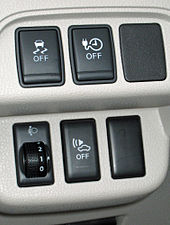
- Warning sounds
The 2011 Leaf includes digital warning sounds, one for forward motion and another for reverse, to alert pedestrians, the blind, and others of its otherwise silent presence.[102][103] For the 2011 model, the driver could turn off sounds temporarily through a switch inside the vehicle, but the system automatically reset to "On" at the next ignition cycle, but Nissan removed the ability to disable the pedestrian alert between model year 2011 and 2012 in anticipation of the U.S. ruling to be issued by the National Highway Traffic Safety Administration.[104][105][106]
After the new sounds were publicized, the U.S. National Federation of the Blind commented that "while it was pleased that the alert existed, it was unhappy that the driver could turn it off."[103] The Leaf's electric warning sound had to be removed for cars delivered in the UK, as the country's law mandates that any hazard warning sound must be capable of being disabled between 11:00 p.m. and 6:00 a.m., and the Leaf's audible warning system does not allow for such temporary deactivation.[107]
Production[edit]
In March 2013 Nissan had an installed capacity to produce 250,000 Leafs per year: 150,000 at Smyrna, Tennessee, 50,000 at Oppama, Japan, and 50,000 at Sunderland, England.[108] The first vehicles sold in the U.S. were produced at Nissan's plant in Oppama, Japan, which started production on 22 October 2010.[34][109] U.S. production began in January 2013, at Nissan's manufacturing facility in Smyrna, Tennessee.[63] Production of the Leaf at Nissan's plant in Sunderland, England, began in March 2013.[110] In March 2013 the Chinese government announced that a partnership between Nissan and Dongfeng Motor to build Leafs was being planned. The production line would be able to produce 10,000 units per year initially, increased to 50,000 units by 2015.[111]
2013 model year[edit]
- Japanese market
In November 2012, Nissan announced the specifications of the updated 2013 model Leaf destined for the Japanese market. The new version extends range on the Japanese cycle from 200 to 228 km (124 to 142 miles), an increase of 14%. Besides adjusting the regenerative braking to improve power generation, Nissan integrated the electric motor, inverter, and AC/DC converter, used lighter parts throughout, and improved the battery module, achieving a weight reduction of 77 kg (170 lb) or 5%.[112][113]
The 2013 Leaf has a larger trunk, with its volume increased from 330 to 370 litres (11.6 to 13 cu ft). The extra space was freed by moving a downsized charger from the back of the car to the front. Other improvements include a new gauge for the battery's charge in percent, and a long-life battery mode available in any charging mode, which only charges the battery to 80% to improve pack life. Also, Nissan introduced the lower-priced S trim in the Japanese market. This model will be priced at just under ¥2.5 million (around US$29,700), almost half a million yen (approximately US$5,950) cheaper than the previous year's entry price.[112][113]
- American market
The 2013 model year Leaf destined for the U.S. market has several key improvements similar to the Japanese version: better range, faster charging capabilities, a more efficient cabin heater, and a lower starting price. According to Nissan USA, several of the changes aim to address shortcomings in the previous Leaf, and feedback from Leaf owners was taken into consideration.[24][85] The 2013 model year Leaf delivers a higher range than the 2012 model with the same 24 kWh battery pack. The efficiency gains come from a combination of improvements to aerodynamics through tweaks to the front fascia that allowed a reduction of the drag coefficient; a more efficient heater; the addition of a driver-selected B-mode that increases regenerative braking; and energy/range management.[24][85]
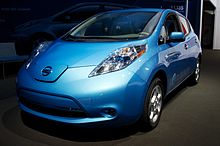
The 2013 model year Leaf has a dashboard display of the battery's charge percentage. A 6.6-kW onboard charger, available as an extra-cost option on the base model, reduces charging times using 240-volt power, so a charge from empty to full takes about four hours, instead of seven.[24][85]
The charge port area now comes with a light, and the ability to open the port door from inside the car or by using the key fob.[85] The onboard charger in all 2013 Leafs is more compact and located under the hood, increasing cargo volume.[24] Nissan introduced a new trim level called the Leaf S model with a lower starting price. The S trim has projector beams instead of LED headlights, and 16-inch steel wheels with hubcaps instead of alloy wheels. The base trim does not include the navigation system or the remote connectivity that allows drivers to turn on the climate control and monitor battery charging remotely using a smartphone.[24] LED headlamps, fog lights, 17-inch alloy wheels and leather seating, are reserved for the higher-end SL trim. Additional premium upgrades to the SL trim include a Bose seven-speaker audio system and around view monitor, which puts cameras in front, in back and on the side mirrors for parking assistance.[85]
The new base-level 2013 Nissan Leaf S starts at US$28,800, the mid-level Leaf SV at US$31,820, and the high-end Leaf SL trim starts at US$34,840. All prices have a mandatory US$850 destination fee added.[114]
- European market
The 2013 European version has many of the same improvements of the Japanese and U.S. versions, including an extended range, greater recyclability, more interior space, better charging performance, and more equipment. Also three versions will be available: Visia, Acenta and Tekna. The Visia version has a lower starting price than the previous model, and the Tekna model has even more standard equipment than the 2011/2012 Leaf. The European version was unveiled at the 2013 Geneva Motor Show, and production of the 2013 model began in March 2013 at the Sunderland plant in the UK, and sales started in June 2013.[16] The price of the 2013 Leaf produced in Sunderland is lower than the one built in Japan,[108][115] and to further reduce the purchase price by GB£5,000, Nissan offered a battery leasing option for all trims produced at Sunderland.[116][117] The leasing option is also available in several European countries, reducing the purchase price by €5,900.[118] This measure, among others, helped to reduce the sales price in Germany, for instance, from roughly €37,000 in April 2012[119] (with battery) to roughly €24,000 in July 2013 (excluding battery lease of €79 per month).[120]
2014 model year[edit]
- American market
The 2014 model year Leaf went on sale in December 2013 in the U.S. The 2014 Leaf is largely the same as the 2013 model year, except:[121]
- RearView Monitor is standard on all trims
- Updated EV-IT functionality with voice destination entry and SMS readout
Second generation (from 2017)[edit]
| Nissan Leaf (ZE1) | |
|---|---|
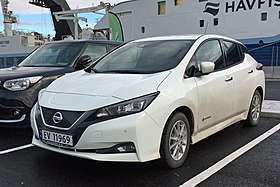 | |
| Overview | |
| Manufacturer | Nissan |
| Production | October 2017–present |
| Model years | 2018–present |
| Assembly | Japan: Oppama Plant, Yokosuka, Kanagawa, Japan United States: Smyrna, Tennessee United Kingdom: Sunderland (NMUK) |
| Powertrain | |
| Electric motor | 110 kW (148 hp), 320 N⋅m (240 lb⋅ft) synchronous motor[122] |
| Transmission | Single speed constant ratio |
| Battery | MY 2018 40 kWh lithium-ion battery[123] |
| Range | MY 2018 243 km (151 miles) EPA[123] 270 km (170 miles) WLTP |
| Dimensions | |
| Wheelbase | 2,700 mm (106.3 in) |
| Length | 4,490 mm (176.8 in) |
| Width | 1,788 mm (70.4 in) |
| Height | 1,530 mm (60.2 in) |
| Curb weight | 1,580–1,640 kg (3,480–3,620 lb) |
On 2 October 2017, for the 2018 model year, Nissan launched the new generation Leaf in Japan, and deliveries in the U.S. and Europe began in February 2018.[124][125][126]
The second-generation leaf has a 40 kWh battery pack with an EPA-rated range of 243 km (151 miles)[123] on a single charge. The electric motor produces 110 kilowatts (147 hp) and 320 newton metres (236 lb⋅ft) of torque.[122] It charges through either a 6.6 kW regular plug (SAE J1772 in US/Japan, or a Type 2 connector in EU countries) or a 50 kW CHAdeMO, and has the ability to send power back to the grid.[127] [[Propilot Assist, a lane centering system, is available on the two highest trim levels for an additional cost, and has automatic parking in some markets.[128]
At CES 2019, Nissan unveiled the Leaf e+ (Leaf Plus in the US), which has a larger 62 kWh battery providing forty percent better range (226 miles versus the regular Leaf 150 miles), and a new 150 kW motor which provides thirty-three percent more power. The Leaf e+ can use CHAdeMO chargers up to 100 kW. Nissan's Intelligent Mobility interface now has a larger eight-inch display, with software updated over the air. Door-to-door navigation, which can sync with smartphones, is also offered along with integrated Nissan energy, a vehicle-to-home system.[129]
Markets and sales[edit]
Nissan officially introduced the Leaf in a ceremony held at its global headquarters in Yokohama on 3 December 2010.[130] The first American customer delivery took place in Northern California on 11 December 2010[131] and the first delivery in Japan took place at the Kanagawa Prefecture on 22 December.[132] Deliveries to individual customers began in Ireland in February 2011, in the UK in March 2011, and in France in August 2011.[133][134][135] Deliveries to corporate customers began in Portugal in December 2010,[136] in the Netherlands in March 2011,[137] and in Canada in July 2011.[138] Retail deliveries began in Spain and Norway in September 2011[139][140] in Switzerland in November 2011,[141] and in Germany in January 2012.[142][143] As of January 2018[update], the Leaf was available in more than 60 countries in four continents.[144]
Nissan sold 49,117 Leafs worldwide in the two years from its introduction in December 2010, making the Leaf the world's best-selling highway-capable electric car.[145] With global sales of more than 22,000 units in 2011,[146] the Leaf surpassed the Mitsubishi i MiEV as the best-selling all-electric car to date.[147] Global sales during 2012 reached 26,973 Leafs, a rise of 22% over 2011 sales, led by Japan with 11,115 units, an 8% increase over 2011 sales; followed by the United States with 9,819 units representing a 1.5% rise over 2011 sales.[148] During the first half of 2012, the Leaf had a market share of 49% of global sales of all-electric cars.[149] 50,000 units had been delivered worldwide by mid February 2013.[150] A total of 47,716 Leafs were sold during 2013, up 77% from 2012,[151] and making the Leaf the world's best-selling plug-in car in 2013.[152]
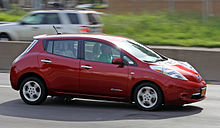
As of mid January 2014, after three years in the market, global sales totaled 100,000 units.[154] During 2014 a total of 61,507 Leafs were sold worldwide.[155] In 2014 the Leaf ranked as the world's best-selling plug-in car for the second consecutive year.[152] Global sales totaled over 158,000 units at the end of 2014.[156]
200,000 Leafs had been sold globally by December 2015.[157][158] Total sales totaled 43,651 units worldwide in 2015, down 29% from 2014,[159] and making the Leaf the world's second best-selling plug-in car in 2015 after the Tesla Model S.[152] The leading market in 2015 was the United States with 17,269 units sold, down 42.8% from 2014,[160] followed by the European market with 15,630 units.[159]
Global sales in 2016 climbed to 51,882 units, including the Chinese-assembled rebadge Venucia e30, helping the Leaf to narrowly surpass the Tesla Model S, and rank as the top selling plug-in car in 2016.[161][162] Sales in 2016 were led by Europe with 18,718 units, followed by Japan with 14,793, North America with 15,512.[152] Global Leaf sales passed the 250,000 unit milestone in December 2016,[163] and the 300,000 mark in January 2018, making the Nissan Leaf the world's best-selling highway-capable electric car to date.[144] As of December 2016[update], the United States ranked as the top-selling market, with 103,597 units delivered,[164][165] followed by Japan with 72,494,[166] and Europe with 67,829 units.[152][155][159] The leading European market was Norway, with 19,407 new units registered up until December 2016.[164][167] Due to the significant number of used imports registered in the country, there were about 27,500 Leafs on Norwegian roads as of 31 December 2016[update].[167][168] The UK ranked second with 15,000 units sold by mid-September 2016.[169]
Global sales in 2017 fell to about 47,000 units, in anticipation of the second generation.[170] When the latter reached the market in 2018, global Leaf sales reached a record level of 87,149 units, third behind the Tesla Model 3 and the BAIC EC-Series.[171]
- Battery leasing option
.jpg)
Initially the Leaf was sold in all markets including the battery pack, and is not compatible with QuickDrop battery swapping developed by its alliance partner Renault.[172][173] In April 2013, Nissan announced that sales of the 2013 Leaf would begin in the UK in June 2013, and that it would offer a battery leasing option for the three available trims. Pricing for the battery leasing in the UK started at GB£70 (~US$108) per month for a 36-month lease limited to not more than 12,100 km (7,500 miles) a year, with a maximum of GB£129 (~US$198) per month for a 12-month lease with no more than 24,000 km (15,000 miles) driven. The battery leasing option lowers the price of the entry-level model to GB£20,990 (~US$32,230) before applying the Plug-in Car Grant.[116][117]
In several European countries, except Norway, Finland, Iceland, Ireland and the Baltic states, the leasing option was also to be offered, reducing the purchase price by €5,900. The battery is priced at €79 (~US$103) monthly for a 36-month lease limited no more than 12,500 km (7,800 miles) a year, with a maximum of €142 (~US$186) per month for a 12-month lease with no more than 25,000 km (16,000 miles) driven.[118]
Global sales[edit]
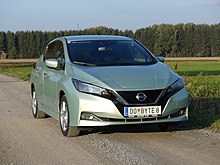
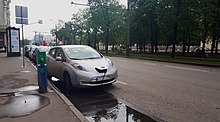
Since its introduction in 2010, more than 400,000 units have been sold worldwide by March 2019, making the Leaf the world best-selling highway-capable electric car to date.[1] As of October 2018[update], the United States ranks as the top-selling market with 126,747 units,[153] followed by Japan with 100,000 units delivered by April 2018,[174] and Europe with 100,000 units by June 2018.[175] The European market is led by Norway with 33,156 new Leafs registered up until October 2018,[164][167][176][177] but due to the significant number of used imports registered in the country, there were 48,235 Leafs on Norwegian roads as of 31 October 2018[update], representing over 25% of total all-electric car registrations in Norway.[178] Ranking second is the UK with over 25,000 units sold by early June 2018,[179] but due to used exports to neighboring countries, only 22,919 were registered at the end of June 2018.[180]
The following table presents retail sales by year since deliveries of the Leaf began in December 2010, for the national markets with cumulative sales of more than 500 units through the end of 2017.
| Country | Total | 2017 | 2016 | 2015 | 2014 | 2013 | 2012 | 2011 | 2010 |
|---|---|---|---|---|---|---|---|---|---|
| US[160][181][182][183][184] | 114,827 | 11,230 | 14,006 | 17,269 | 30,200 | 22,610 | 9,819 | 9,674 | 19 |
| Japan[152][155][185][186][187] | 96,999 | 16,925 | 14,793 | 9,057 | 14,177 | 13,021 | 11,115 | 10,310 | 19 |
| Norway[176][188][189][190][191] | 22,781 | 3,374 | 4,162 | 3,189 | 4,781 | 4,604 | 2,298 | 373 | |
| UK[192][193][194][195] | 22,359 | 5,463 | 4,463 | 5,236 | 4,051 | 1,812 | 699 | 635 | |
| France[196] | 12,113 | 2,381 | 3,887 | 2,200 | 1,600 | 1,438 | 524 | 83 | |
| Canada[197] | 5,519 | 946 | 1,375 | 1,233 | 1,085 | 470 | 240 | 170 | |
| Germany[198][199][200][201] | 4,918 | 841 | 1,121 | 831 | 812 | 855 | 451 | 7 | |
| China[202][203] | 4,032[a] | 1,961 | 1,273 | 582 | 216 | ||||
| Netherlands[204][205][206][207] | 3,157 | 513 | 666 | 447 | 510 | 462 | 265 | 294 | |
| Sweden[208][209][210][211] | 3,542 | 981 | 836 | 841 | 438 | 317 | 129 | ||
| Spain[212][213][214][215][216] | 2,159 | 530 | 344 | 344 | 465 | 263 | 154 | 59 | |
| Italy[217][218][219][220][221] | 2,103 | 448 | 460 | 389 | 332 | 323 | 146 | 5 | |
| Denmark[222] | 1,202 | 20 | 85 | 224 | 577 | 211 | 73 | 12 | |
| Ireland[223][224][225][226][227] | 1,366 | 258 | 352 | 405 | 192 | 43 | 69 | 45 | 2 |
| Belgium[228][229][230][231][232] | 1,510 | 389 | 466 | 162 | 178 | 141 | 114 | 60 | |
| Austria[233] | 1,151 | 384 | 333 | 156 | 121 | 88 | 64 | 3 | |
| Australia[234][235][236][237] | 997[b] | 384 | 156 | 109[b] | 173 | 188 | 77 | 19 | |
| Switzerland[238] | 831 | 131 | 158 | 145 | 106 | 178 | 74 | 39 | |
| Total top markets | 293,545 | 44,814 | 49,624 | 43,354 | 60,259 | 47,152 | 26,247 | 21,785 | 40 |
| Total global sales[146][148][151][155][156][159][152][170] | 303,678 | ~47,000 | 49,245 | 43,651 | 61,507 | 47,716 | 26,973 | 22,094 | 50 |
- ^ Chinese sales correspond to the rebadged Venucia e30.
- ^ Jump up to: a b Sales in Australia through September 2015.
Reported problems[edit]
This section may require cleanup to meet Wikipedia's quality standards. The specific problem is: See Wikipedia talk:WikiProject Automobiles/Archive 39#Recalls-notability. This level of detail is considered excessive by the Automobiles project. Generally, to be mentioned, problems need to have had widespread reporting in mainstream media. (January 2019) (Learn how and when to remove this template message) |
- Initial problems
In April 2011, Nissan announced that customers in the United States and Japan reported problems in restarting their Leaf vehicles after switching the motor off. Nissan said the problem does not pose any accident risk.[239] On 15 April. Nissan announced that the problem only affected a small proportion of Leafs. Nissan engineers identified a programming error in an air conditioning system sensor that sometimes triggers an erroneous high voltage alert when the air conditioning unit is switched on, due to the increased demand for power. The system issues an Inhibit Restart command, which does not prevent driving the vehicle, but does prevent it restarting after it is turned off. The solution requires reprogramming of the Vehicle Control Module by a Nissan dealer. Nissan announced a "service campaign" to apply the software fix to all 5,300 Nissan Leafs in operation around the world, but it was not an official recall because it was not a safety problem.[240][241][242] The applied software update also improves the car's on-board range calculation system, which several Leaf owners reported was overestimating the number of miles left. In addition, the update changes the state-of-charge bars display to provide a true reserve capacity; the driver now has up to five miles to find a charging spot after the car reaches the zero miles remaining mark.[243]
- Battery capacity loss
In May 2012, several U.S. owners reported seeing only 11 of 12 battery capacity bars on the in-car display which led them to believe they had lost some battery capacity. As time went on, more people reported seeing the problem, and some had lost two, three, and even in rare cases, four battery capacity bars. The battery capacity loss problem seems to be concentrated in regions with a hot climate, and Phoenix, Arizona and the state of Texas in particular. In July 2012, Nissan responded by saying they were investigating the problem, and a carmaker spokesman also said that "the problem is isolated to maybe 0.3% of the 13,000 Leafs on U.S. roads," the company reportedly has loaned cars to some Leaf owners in Arizona as it researches the issue. This is equivalent to around 40 vehicles that have experienced a loss of any battery capacity bars.[244][245]
By early September 2012, a Nissan Executive Vice President said that there is "no problem with the Leaf battery, and that any customer complaints were merely the result of instrument problems."[246] As a response, a group of 12 Phoenix Leaf owners participated in an independent test in controlled conditions organized by Leaf driver and EV advocate Tony Williams that took place on 15 September 2012. The test confirmed that the Leaf has poor instruments, but the test also found significant loss of range in some cars reflecting battery capacity loss. The worst affected Leaf showed around 60 to 65% of its original battery capacity remaining, and was only capable of driving 95 km (59 miles) before running out of charge.[246][247][248]
Based on a complete evaluation that Nissan Americas conducted with seven different Leafs in its Arizona Testing Center, the carmaker found that the common link among the seven Leafs from Arizona was that all of them had covered much higher mileage than the 20,100 km (12,500 miles) Nissan used to estimate the rate of battery capacity loss over time. All of them had covered at least 50% more than the Nissan estimated average, with 31,500 km (19,600 miles) as the average mileage for the cars evaluated. According to Nissan, that average is "more than double the average Phoenix customer mileage of 7,500 miles per year." Nissan concluded that "the cars and the battery packs are behaving as we expected."[249][250] As a result of this assessment, Nissan published an open letter to Leaf owners explaining the results of the assessment and the details of normal battery capacity loss expected over time. The company also decided to set up an independent advisory board to study how the company may improve its communication with customers about the performance of the Leaf. The group will be led by Chelsea Sexton, known for her prominent role in the marketing of the GM EV-1 electric car. She will select the members of the advisory board that would make recommendations to Nissan.[250] By late September Nissan reported that around 450 Leafs have been sold in Arizona, and in the interest of customer satisfaction, two units with battery loss problems were repurchased using the buyback formula modeled on Arizona's lemon law.[251][252] One of the owners that had their Nissan Leaf repurchased established a blog in order to persuade other potential Nissan Leaf buyers in hot climates to reconsider buying this particular vehicle.[253][better source needed] By mid September, Nissan's CEO Carlos Ghosn announced that there is an improved second generation battery coming online that will cost less than the previous one.[254]
In January 2013, Nissan USA announced that it will offer an extended battery warranty on the 2013 model year Leaf and will include 2011 and 2012 model years as well.[43]
A 2015 report by insurance company Warranty Direct, stated that of 35,000 Leafs sold in Europe, three had a battery failure. That is 0.01% cars immobilized compared to 0.255% for internal combustion engined cars.[255]
On 24 September 2012, a Class Action Complaint against Defendants Nissan Motor Company Ltd, Nissan North America Inc., was filed by California Plaintiff Humberto Daniel Klee and Arizona Plaintiff David Wallak. The class action stated “Before purchase or lease, Nissan failed to disclose its own recommendations that owners avoid charging the battery beyond 80% in order to mitigate battery damage and failed to disclose that Nissan’s estimated 100 mile range was based on a full charge battery, which is contrary to Nissan’s own recommendation for battery charging.” It accused Nissan of concealing that its Leaf vehicles had a design defect that causes them to prematurely lose battery life and driving range, charging Nissan with violations of California's Consumer Legal Remedies Act, Arizona's Consumer Fraud Act and Unfair Business Act, negligent misrepresentation, and breach of Implied Warranty under the Song-Beverly Consumer Warranty Act. On 7 July 2015, U.S. Circuit Judge A. Wallace Tashima of the 9th Circuit U.S. approved the class action settlement in the U.S. District Court for the Central District of California, valued at $24 million.[256]
In March 2018, a study in New Zealand showed accelerated reported battery decline in 30 kWh Leafs compared to 24 kWh Leafs.[39] In response to this problem, Nissan issued a software fix, on 6 June 2018 in the USA [257] and somewhat later in New Zealand.[258] Consumer NZ advises affected owners to "go back to the dealer who sold the car (also likely to be the importer) and ask it to pay for the software update. You can also claim any reasonable costs you incur to get your car repaired."[259]
Related cars[edit]
- Leaf Aero Style
Nissan unveiled the Nissan Leaf Aero Style concept car at the 2011 Tokyo Auto Salon. The Leaf Aero Style exterior has a new front bumper, extended side skirts, restyled mirrors, LED daytime driving lights, and special wheels.[260][261]
- Leaf Nismo
Nissan unveiled the Leaf Nismo RC (Racing Competition) demonstration car at the 2011 New York International Auto Show. This electric car has the same battery pack and motor as the Leaf but is designed and constructed as a racing car with a full carbon fiber monocoque body which makes it about 40% lighter than the production Leaf.[262] Leaf Nismo RC is projected to have a running time of around 20 minutes under racing conditions, and in preliminary testing it accelerated from 0 to 62 mph (0 to 100 km/h) in 6.85 seconds and has a top speed of 93 mph (150 km/h).[263][264] Nissan built eight of these rear-wheel drive cars.[262]
Another concept from Nismo was unveiled at the 2011 Tokyo Motor Show, the Leaf Nismo Concept. It was designed as normal highway-capable automobile and uses the same 80 kW electric motor as the Leaf.[265] In January 2013, Nissan announced that the Leaf Nismo will be produced in low volumes by mid-2013, and sold in Japan only. The Leaf Nismo uses the Leaf's all-electric drive train with no extra power or performance improvements, but has an aerodynamic body kit with styling influenced by the electric Leaf RC demonstrator, new alloy wheels, and interior improvements.[266]
- Infiniti LE
The Nissan Infiniti LE concept all-electric car was unveiled at the 2012 New York International Auto Show. It is based on the same platform as the Leaf, but it is expected to become Nissan's luxury electric car. It was expected to go into production in 2014.[267] In May 2013 the company said that it was waiting for inductive charging industry standards before launching the vehicle.[268][269]
- Venucia e30
Nissan and its joint venture partner Dongfeng Motor unveiled a production version of the Venucia e30 electric car at the 2012 Auto Guangzhou. An earlier version, the Venucia E-Concept, was unveiled at the 2012 Beijing Auto Show. The car was initially scheduled for production in China by 2015. The Venucia e30 shares the bodywork, dimensions, electric-drive specifications and several other aspects of the Leaf. Dongfeng Nissan started pilot projects in 15 Chinese cities to promote the Venucia e30 with local governments.[270][271] A total of 216 units were delivered in December 2013. These units were marketed as Venucia Morning Wind and they were badged Leafs since local production had not begun at the time.[202] In April 2014 Dongfeng Nissan announced that retail sales of the Venucia e30 were going to begin ahead of schedule.[272]
The Venucia e30 was launched in the Chinese market in September 2014.[273] The e30 has the same 24 kWh lithium ion battery as the Nissan Leaf, with an energy consumption of 14.6 kWh/100 km and a range of 160 km (99 miles).[274]
Infiniti LE concept car
- Autonomous car

In August 2013, Nissan announced its plans to launch several driverless cars by 2020. The company is building in Japan a dedicated autonomous driving proving ground, to be completed in 2014. Nissan installed its autonomous car technology in a Nissan Leaf for demonstration purposes. The car was demonstrated at the Nissan 360 test drive event held in California in August 2013.[275][276] In September 2013, the Leaf fitted with the prototype Advanced Driver Assistance System was granted a license plate that allows it to drive on Japanese public roads. The test car will be used by Nissan engineers to evaluate how its in-house autonomous driving software performs in the real-world. Time spent on public roads will help refine the car's software for fully automated driving.[277] The autonomous Leaf was demonstrated on public roads for the first time at a media event held in Japan in November 2013. The Leaf drove on the Sagami Expressway in Kanagawa prefecture, near Tokyo. Nissan vice chairman Toshiyuki Shiga and the prefecture's Governor, Yuji Kuroiwa, rode in the car during the test.[278][279]
Motorsport[edit]
An Electric Production Class was formed for the 2011 Pikes Peak International Hill Climb and Chad Hord raced a Leaf in the event.[280] The off-road racing driver ascended the 19.99 km (12.42 miles) course in 14 minutes and 33 seconds to win the class.[281] The interior of the car was removed and replaced with mandatory racing seats, safety harness, and a roll cage.[282]
Reception[edit]

There were 20,000 pre-orders in the United States for the vehicle's debut.[283] After hitting this milestone in September 2010, Nissan stopped taking reservations in the United States until many of the initial orders had been delivered in early 2011.
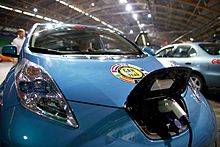
Awards[edit]
The Leaf has received awards from multiple organizations. Notable awards include the inclusion by Time magazine as one of the 50 best inventions of 2009.[284] At the 2010 Washington Auto Show, the Leaf was given the 2010 Green Car Vision Award by the Green Car Journal, which said that the Leaf "will provide the features, the styling, and the driving experience that will meet the needs of a sophisticated and demanding market, while producing zero localized emissions and requiring no petroleum fuels."[285] Popular Mechanics, upon awarding the Leaf its 2010 Breakthrough Award, explained that the Nissan Leaf is "not the first pure EV, but [...] hits the mainstream like none of its predecessors." Popular Mechanics also alluded to the Leaf's 160 km (100 miles) range, which is said to be "enough for most commuters for the price of an average vehicle – and with a much lower operating cost than gasoline-powered vehicles."[286]
Other awards received by the Leaf include the 2011 European Car of the Year,[287] EV.com's 2011 EV of the Year,[288] 2011 Eco-Friendly Car of the Year by Cars.com,[289] 2011 Green Fleet Electric Vehicle of the Year,[290] it was listed among the 2011 Greenest Vehicles of the Year by the American Council for an Energy-Efficient Economy,[291][292] also listed by Mother Earth News among its "Best Green Cars" of 2011,[293] and also was ranked first in Kelley Blue Book Top 10 Green Cars for 2011.[294] The Leaf won the 2011 World Car of the Year,[295] and was a finalist for the 2011 World Green Car.[296] Ward's Auto listed the Leaf's 80 kW electric motor in Ward's 10 Best Engines for 2011.[297] Until October 2011 the Leaf was ranked as the most efficient EPA certified vehicle for all fuels ever.[298][299] In December 2011, the Leaf was awarded with the 2011–2012 Car of the Year Japan at the Tokyo Motor Show.[300]
Criticism[edit]
In 2009, a former Tesla Motors marketing manager criticized Nissan for the lack of effective thermal management system of lithium-ion battery packs.[301] He also said there may be an overestimation of the 160 km (100-mile) range that was computed using LA-4 or "city" mode, which may underestimate the energy draw during highway driving conditions.[301][302]
The American magazine Consumer Reports noted that while charger costs vary between US$700 and US$1,200, an at-home charger and its installation cost more than US$2,000 even for simple installations.[303] Nissan estimates a typical charger installation costs US$2,200. The article did not mention that home charger installations were eligible for a 50% federal tax credit up to US$2,000.[304] Consumer Reports noted that the first 5,700 Leaf buyers could get free chargers with federal support in 13 cities. The consumer group also reminded that many older houses could require upgrading the electric service panel to install a 240-volt circuit, which can cost several thousand dollars.[303] The additional 220–240-volt charger is required in the countries—mainly in the Americas—that do not have a 220–240-volt domestic grid, if an owner wants faster charging than under 110–120-volt.
There are a variety of EVSE manufacturers for the Nissan Leaf including SPX, Schneider, Leviton, Aerovironment, Blink and GE. Some are priced at less than $850. Since the on-board charger in the Leaf can draw as little as 15 amps, many home installations can be as simple as adding a dedicated 20 amp circuit and receptacle in the garage.
Consumer Reports also called buyers' attention to the fact that the Leaf's total out-of-pocket costs include a US$595 acquisition fee and a US$395 disposition fee. The consumer group also emphasized that the lease price of US$349-a-month applies only to buyers with good credit (Tier 1, or a FICO score of 700 or above); for those with less than optimum credit, the monthly rate would increase. They reminded buyers that the lease comes with a 23,000 km/year (15,000-mile-per-year) allowance, but additional miles will cost extra.[305]
One study showed that some of the 30 kWh Nissan Leaf battery packs are degrading at around three times the rate of the 24 kWh variant at 2 years of age.[306] This was eventually found to be an instrumentation problem, and has since been rectified by a software update.[307]
See also[edit]
- Electric car use by country
- EV Project
- Government incentives for plug-in electric vehicles
- List of best-selling automobiles
- List of electric cars currently available
- List of modern production plug-in electric vehicles
- List of Nissan vehicles
- List of production battery electric vehicles
- Nissan electric vehicles
- Plug-in electric vehicle
- Renault Z.E., from Nissan-Renault Group
- Revenge of the Electric Car
- Zero-emissions vehicle
References[edit]
- ^ Jump up to: a b c "Nissan LEAF first electric car to pass 400,000 sales" (Press release). Yokohama: Nissan. 5 March 2019. Retrieved 6 March 2019.
- ^ "All-New Nissan Altra EV: A Friendly, High-Tech Electric Vehicle for Everyday Life". The Auto Channel. 29 December 1997. Retrieved 23 December 2010.
- ^ "Nissan Altra Electric Retrieved from Vacaville". After Gutenberg. 2 July 2006. Archived from the original on 23 November 2008. Retrieved 23 December 2010.
- ^ "California Commuter". EV World. 31 January 2001. Archived from the original on 17 November 2007. Retrieved 23 December 2010.
- ^ "Start of Joint Field Demonstration Project Using Nissan's Hypermini" (Press release). Nissan. 13 January 2000. Archived from the original on 27 September 2011. Retrieved 29 October 2011.
- ^ Brayer, Roberta; Francfort, James (January 2006). "Nissan Hypermini Urban Electric Vehicle Testing" (PDF). U.S. Department of Energy. Archived from the original (PDF) on 15 October 2011. Retrieved 29 October 2011.
- ^ Jump up to: a b Abuelsamid, Sam (27 July 2009). "Nissan shows off new Versa-based electric vehicle prototype". Autoblog.com. Retrieved 11 December 2010.
- ^ "Nissan shows test models of electric car, hybrid". MSNBC News. Associated Press. 6 August 2008. Retrieved 25 April 2010.
- ^ Goodwin, Antuan (2 April 2009). "Test-driving the Nissan EV-02 electric car". CNET. Retrieved 25 April 2010.
- ^ Paukert, Chris (1 August 2009). "2010 Nissan Leaf electric car: In person, in depth – and U.S. bound". Autoblog.com. Retrieved 11 December 2010.
- ^ "Nissan unveils "Leaf" – the world's first electric car designed for affordability and real-world requirements" (Press release). Nissan. 2 August 2009. Archived from the original on 10 February 2012. Retrieved 13 May 2010.
- ^ Jump up to: a b "The new car: features and specifications". USA: Nissan. Archived from the original on 13 December 2011. Retrieved 13 December 2011.
- ^ "2012 Nissan Leaf: Specifications". Cars.com. Archived from the original on 7 September 2012. Retrieved 26 June 2012.
- ^ Jump up to: a b c d e f g "Compare Side-by-Side: 2014 Nissan Leaf; 2015 Nissan Leaf; 2016 Nissan Leaf (30 kW-hr battery pack); 2016 Nissan Leaf (24 kW-hr battery pack)". Fueleconomy.gov. U. S. Environmental Protection Agency and U.S. Department of Energy. 6 January 2015. Retrieved 6 November 2015.
- ^ Jump up to: a b c John Voelcker (21 February 2013). "2013 Nissan Leaf gets 75-mile range (actually 84) in new EPA test". Green Car Reports. Retrieved 26 February 2013.
- ^ Jump up to: a b c Philippe Crowe (27 February 2013). "European-Specific Nissan Leaf To Be Unveiled In Geneva". HybridCars.com. Retrieved 27 February 2013.
- ^ "Charging at home". USA: Nissan. Retrieved 7 August 2013.
[...] is easy with a 240-volt home charging dock [...] with the 6.6 kW onboard charger
- ^ "Nissan DC Quick Charger". USA: Nissan. Archived from the original on 25 November 2013. Retrieved 7 August 2013.
480 volts, 44 kW maximum [...] charging fully depleted Nissan Leaf (24 kWh capacity) to 80% in 30 minutes [editor note: more than 40 kW will only be used on a fully depleted battery, normal charging power is around 20 kW]
- ^ Jump up to: a b c d "2011 Nissan Leaf Features & Specs". Edmunds.com. Retrieved 1 January 2011.
- ^ Jump up to: a b c "2011 Nissan Leaf Road Test". Edmunds.com. Retrieved 1 January 2011.
- ^ "2013 Nissan Leaf S 4dr Hatchback 0-cyl. Electric 1-speed Direct Drive Features and Specs". Edmunds.com.
- ^ Loveday, Eric (3 August 2010). "2011 Nissan Leaf: Design Aimed at Mainstream Appeal". AllCarsElectric. Retrieved 21 December 2010.
- ^ "Quick Comparison: 2011 Nissan Leaf vs. 2012 Mitsubishi i-MiEV". Motor Trend. 3 August 2010. Retrieved 3 August 2010.
- ^ Jump up to: a b c d e f g Voelcker, John (9 January 2013). "2013 Nissan Leaf: Longer Range, Faster Charging, Leather Seats, And More: All The Upgrades". Green Car Reports. Retrieved 10 February 2013.
- ^ Sherman, Don (June 2014). "Drag Queens: Aerodynamics Compared – Comparison Test". Car and Driver. Retrieved 20 August 2016.
- ^ Jump up to: a b Blanco, Sebastian (27 May 2010). "Details on Nissan Leaf battery pack, including how recharging speed affects battery life". AutoblogGreen. Retrieved 30 May 2011.
- ^ Nunn, Peter (23 June 2010). "2011 Nissan Leaf Prototype (Japan) First Drive". Edmunds Inside Line. Retrieved 1 January 2011.
- ^ "Nissan Zero Emission Website | Nissan Leaf | Specs". Nissan-zeroemission.com. Archived from the original on 25 November 2010. Retrieved 11 December 2010.
- ^ Williams, Tony (25 February 2013). "Real World Test: 2013 Nissan Leaf Range vs 2012 Nissan Leaf Range (w/Video)". Inside EVs. Retrieved 23 April 2015.
- ^ Lohse-Busch, Henning; Duoba, Michael (15 May 2012). "Advanced Technology VehicleLab Benchmarking – Level 1" (PDF). Argonne National Laboratory. p. 9. Retrieved 23 April 2015.
- ^ "Details on Nissan Leaf battery pack, including how recharging speed affects battery life". AutoblogGreen. 27 May 2010. Retrieved 27 May 2010.
- ^ Jump up to: a b c "13 Key Questions and Answers about Nissan Leaf Battery Pack and Ordering". HybridCars.com. 27 May 2010. Archived from the original on 30 May 2010. Retrieved 31 May 2010.
- ^ "Nissan's Leaf up close". CNN. 17 February 2010. Retrieved 28 May 2010.
- ^ Jump up to: a b "Production of 100% Electric, Zero-Emission Nissan Leaf begins at Oppama, Japan". Nissan News. 22 October 2010. Archived from the original on 1 January 2011. Retrieved 6 January 2011.
- ^ "2011 Leaf Owner's Manual" (PDF). Nissan. Retrieved 14 May 2011. See pages EV2 and EV22 – EV Overview.
- ^ Krivevski, Blagojce (27 June 2014). "2015 Nissan Leaf". ElectricCarsReport. US. Retrieved 2 March 2019.
- ^ "2011 Nissan Leaf US pricing officially announced: as low as $25,280*". GreenAutoBlog. 30 March 2010. Retrieved 30 March 2010.
- ^ Jump up to: a b "Nissan Leaf Technology FAQ". Nissan USA. Archived from the original on 17 July 2011. Retrieved 4 June 2012.
Q: How many charging cycles can the energy storage device survive? A: Like all lithium ion batteries, the Nissan Leaf battery will experience gradual capacity loss over time. We expect the battery to last over ten years, however, there may be a gradual loss of capacity of 30% or more depending on your driving patterns, and the effect on your battery. The battery can be used afterward for storage applications.
- ^ Jump up to: a b Myall, Daniel; Ivanov, Dima; Larason, Walter; Nixon, Mark; Moller, Henrik (15 March 2018). "Accelerated Reported Battery Capacity Loss in 30 kWh Variants of the Nissan Leaf". Preprints. 2018: 2018030122. doi:10.20944/preprints201803.0122.v1. Retrieved 18 March 2018.
- ^ "Nissan to Warranty Leaf Battery for 8 Years, 100,000 Miles". Green Car Congress. 27 July 2010. Retrieved 27 July 2010.
- ^ Valdes-Dapena, Peter (27 July 2010). "Chevy Volt priced at $41,000". CNN Money. Retrieved 27 July 2010.
- ^ Schwarzer, Christoph M. (1 April 2015). "Batterie-Upgrade? Unwahrscheinlich!" [Battery upgrade? Unlikely!]. Die Zeit (in German). Retrieved 8 March 2016.
- ^ Jump up to: a b Glon, Ronan (28 December 2012). "2013 Nissan Leaf gets extended battery warranty". Left Lane News. Retrieved 10 January 2013.
- ^ "New Nissan Leaf". Green Car Guide. 5 March 2013. Retrieved 12 March 2013.
- ^ Blanco, Sebastian (20 June 2013). "Nissan Leaf battery replacement will cost $100/month, offers new pack at any time". AutoblogGreen. Retrieved 23 June 2013.
- ^ Brockman, Brian (7 June 2014). "Update on Nissan Leaf Battery Replacement". MyNissanLeaf. Retrieved 10 July 2013.
- ^ Voelcker, John (28 June 2014). "Nissan Leaf New Battery Cost: $5,500 For Replacement With Heat-Resistant Chemistry". Green Car Reports. Retrieved 26 September 2018.
- ^ "Nissan Prices Leaf Battery Replacement at $5,500 | Edmunds". Edmunds. Retrieved 26 September 2018.
- ^ Gordon-Bloomfield, Nikki (26 September 2018). "Nissan Quietly Increased The Price of Its LEAF Battery Replacement. What now?". Transport Evolved. Retrieved 26 September 2018.
- ^ Evarts, Eric (8 December 2011). "Leaf, Volt tests show electric cars cost less per mile to operate". Consumer Reports. Archived from the original on 8 January 2012. Retrieved 9 December 2011.
- ^ Nissan (23 June 2012). "Nissan launches Leaf "taxi" campaign in London". Green Car Congress. Retrieved 25 June 2012.
- ^ Michelle Krebs (28 February 2012). "Will Higher Gas Prices Boost Hybrid, EV Sales?". Edmunds.com. Retrieved 29 February 2012.
- ^ Nick Bunkley (4 April 2012). "Payoff for Efficient Cars Takes Years". The New York Times. Retrieved 7 April 2012.
- ^ TrueCar (4 April 2012). "The Cost of Higher Fuel Economy". The New York Times. Retrieved 7 April 2012.
- ^ Jump up to: a b c Nick Bunkley (22 November 2010). "Nissan Says Its Electric Leaf Gets Equivalent of 99 M.P.G." The New York Times. Retrieved 23 November 2010.
- ^ Jump up to: a b "US EPA rates Nissan Leaf fuel economy as 99 miles per gallon equivalent (combined); 73-mile range". Green Car Congress. 22 November 2010. Retrieved 23 November 2010.
- ^ Peter Valdes-Dapena (24 November 2010). "Nissan Leaf: 99 miles per gallon". CNN. Retrieved 19 June 2013.
- ^ "Nissan Leaf Specs". Nissan. Archived from the original on 25 November 2010. Retrieved 3 August 2009.
- ^ Nissan (3 February 2011). "The Age Of Electric Motoring Begins In Europe". Nissan News Room. Archived from the original on 9 August 2011. Retrieved 26 May 2011.
- ^ Jerry Garrett (16 July 2010). "Driving the Nissan Leaf Electric Car Reveals Range Variability". The New York Times. Retrieved 17 July 2010.
- ^ "Nissan Leaf has 100-mile range—give or take 40 percent". CNET. 21 June 2010. Retrieved 26 June 2010.
- ^ "2011 Nissan Leaf". fueleconomy.gov. United States Environmental Protection Agency. 2011. Retrieved 11 October 2011.
- ^ Jump up to: a b David Shepardson (20 March 2012). "Nissan to debut improved Leaf in December". The Detroit News. Retrieved 21 March 2012.[permanent dead link]
- ^ Jump up to: a b Alex Nishimoto (21 February 2013). "2013 Nissan Leaf Gets Projected Range of 75 Miles, 84 Miles by Old Standard". Motor Trend. Retrieved 26 February 2013.
- ^ John Voelcker (8 February 2013). "2013 Nissan Leaf: Efficiency Up 15 Percent To 115 MPGe From 99 MPGe". Green Car Reports. Archived from the original on 14 February 2013. Retrieved 11 February 2013.
- ^ U.S. Environmental Protection Agency and U.S. Department of Energy (16 May 2013). "2013 Nissan Leaf". Fueleconomy.gov. Retrieved 16 May 2013.
- ^ "2015/2014/2013/2012 Nissan Leaf". fueleconomy.gov. United States Environmental Protection Agency. 27 May 2014. Retrieved 28 May 2014.
- ^ Jay Cole (8 January 2014). "2014 Nissan Leaf: Mostly Unchanged As Range Technically Moves Up To 84 Miles". InsideEVs.com. Retrieved 30 May 2014.
- ^ "New 2016 Nissan Leaf now offers best-in-class 107-mile range in affordable, fun-to-drive package" (Press release). USA: Nissan. 10 September 2015. Retrieved 21 September 2015.
- ^ Jump up to: a b "Nissan Leaf S quietly gets 30-kwh battery upgrade, higher price". USA: Nissan. 11 October 2016. Retrieved 11 October 2016.
- ^ "Compare Side-by-Side". fueleconomy.gov. U.S. Department of Energy. Retrieved 2 December 2016.
- ^ "2016 Nissan Leaf Specifications" (PDF). nissannews.com. Nissan. Retrieved 24 January 2019.
- ^ "2019 Nissan Leaf (40 kW-hr battery pack)". www.fueleconomy.gov. Retrieved 24 April 2019.
- ^ "2019 Nissan LEAF Charging & Range | Nissan USA". Nissan. Retrieved 24 April 2019.
- ^ Eric Loveday (11 February 2014). "Nissan Leaf Has Smallest Lifecycle Footprint of Any 2014 Model Year Automobile Sold in North America". Inside EVs. Retrieved 22 February 2014.
- ^ Automotive Science Group (ASG) (4 February 2014). "Life-cycle Assessment of 1,300 Models Reveals Best of 2014". ASG Press Room. Archived from the original on 2 March 2014. Retrieved 22 February 2014.
- ^ Richardson, Jake (10 December 2014). "1 Billion Kilometers Driven By Nissan Leafs". Clean Technica. Retrieved 15 October 2016.
- ^ "New Nissan Electric Café opens in Paris as the brand celebrates three billion EV kilometres worldwide" (Press release). Paris: Nissan Newsroom Europe. 16 December 2016. Retrieved 17 December 2016.
- ^ Eric Loveday (9 April 2010). "Nissan and AeroVironment show off prototype $2,200 Leaf home charger". Autoblog Green. Retrieved 13 April 2010.
- ^ "Tokyo Electric Power Licenses Aker Wade to Build Level III Fast Chargers". Green Car Congress. 15 January 2010. Retrieved 13 April 2010.
- ^ "Exclusive interview with the CEO of Aker Wade: "Standardisation is the key"". cars21.com. 29 April 2010. Retrieved 13 May 2010.
- ^ Nissan. "Nissan Leaf Electric Car | The New Car – Features and Specifications". Archived from the original on 27 April 2010. Retrieved 18 August 2010.
- ^ Jump up to: a b c d "Nissan Leaf Electric Car | Answers | Charging". Nissan. Archived from the original on 24 April 2010. Retrieved 25 May 2010.
- ^ Jump up to: a b Sawyer, Christopher (February 2009). "Nissan's EV and Battery Plans". Automotive Design and Production. Archived from the original on 31 March 2010. Retrieved 10 October 2009.
- ^ Jump up to: a b c d e f Bradley Berman (13 January 2013). "Nissan Gives Leaf Owners a Preview of the 2013 Model". The New York Times. Retrieved 11 February 2013.
- ^ Nick Chambers (27 May 2010). "Nissan Leaf Will Include Fast Charge Capability and Emergency Charging Cable at Launch". Gas2.0. Retrieved 13 June 2010.
- ^ Squatriglia, Chuck (2 September 2009). "Nissan Turns Over An Electric Leaf". Wired News. Retrieved 13 May 2010.
- ^ "Renault-Nissan, EDF to develop e-cars and infrastructure in France". EE Times Europe automotive. EETimes. 10 October 2008. Retrieved 21 May 2010.
- ^ Jump up to: a b Domenick Yoney (23 December 2010). "Nissan Leaf's CARWINGS keeps you up to speed, puts you in efficiency race". AutoblogGreen. Retrieved 9 January 2011.
- ^ Sam Abuelsamid (28 January 2008). "Nissan Carwings telematics system gets environmental award in Japan". AutoblogGreen. Retrieved 9 January 2011.
- ^ Michael Austin (5 January 2011). "Nissan Launches CARWINGS Connected System for Leaf with Remote Control and Eco Rankings". Car and Driver. Retrieved 9 January 2011.
- ^ "2011 & Newer – Search Results Safercar – National Highway Traffic Safety Administration (NHTSA)".
- ^ Cheryl Jensen (26 April 2011). "Chevrolet Volt and Nissan Leaf Earn Top Marks in First U.S. Crash Tests". The New York Times. Retrieved 27 April 2011.
- ^ "Chevrolet Volt & Nissan Leaf earn top ratings in 1st U.S. crash tests of mainstream electric cars". Insurance Institute for Highway Safety News Release. 26 April 2011. Retrieved 28 April 2011.
- ^ "Euro NCAP results for Nissan Leaf" (PDF). euroncap.com. 2011.
- ^ AOL Autos (16 December 2011). "Chevy Volt Unplugged: When To Depower Your EV After a Crash". Translogic. Retrieved 20 December 2011.
- ^ Nissan (2010). "2011 Leaf First Responder's Guide" (PDF). Nissan North America. Retrieved 20 December 2011.
- ^ Nick Chambers (20 December 2010). "Nissan Leaf First Responders Manual Highlights Special Needs of Electric Cars in Emergencies". PluginCars. Retrieved 20 December 2011.
- ^ Bill Vlasic & Nick Bunkley (7 December 2011). "G.M. Re-examines Volt as Safety Concerns Rise". The New York Times. Retrieved 8 December 2011.
- ^ Nick Bunkley (21 December 2011). "Tsunami Reveals Durability of Nissan's Leaf". The New York Times. Retrieved 2 January 2012.
- ^ David Welch (1 December 2011). "GM's Volt Battery Fires Threaten to Disrupt 'Moon Shot': Cars". Bloomberg Businessweek. Retrieved 8 December 2011.
- ^ Jim Motavalli (1 June 2010). "Electric Car Warning Sounds: Don't Expect Ring Tones". The New York Times. Retrieved 2 June 2010.
- ^ Jump up to: a b Jim Motavalli (17 June 2010). "Blind Advocates 'Disappointed' in Nissan E.V. Sounds for Pedestrians". The New York Times. Retrieved 19 June 2010. The article includes a sample of the two sounds.
- ^ Jay Cole (7 January 2013). "All EVs Operating Under 18 MPH To Have Audible Warning". InsideEvs.com. Retrieved 22 March 2013.
- ^ "Nissan demonstrates the affordable, 100% electric, zero-emission Nissan Leaf". Nissan. 11 June 2010. Archived from the original on 14 June 2010. Retrieved 15 June 2010.
- ^ "JAPAN: Nissan makes Leaf noisier at low speed". Just Auto. 11 June 2010. Retrieved 15 June 2010.
- ^ Andy Richardson (1 March 2011). "Nissan Leaf facing delay". The Northern Echo. Retrieved 24 June 2012.
- ^ Jump up to: a b Jay Cole (28 March 2013). "Nissan Leaf Production Starts At 3rd Assembly Plant In Sunderland, UK (Factory Video)". InsideEVs.com. Retrieved 29 March 2013.
- ^ Jim Motavalli (12 February 2010). "Nissan Leaf Electric Car Comes to New York". The New York Times. Retrieved 13 February 2010.
- ^ Sebastian Blanco (28 March 2013). "Nissan starts 2013 Leaf production in UK, EV now made on three continents". Autoblog Green. Archived from the original on 1 May 2016. Retrieved 28 March 2013. See Press Release.
- ^ Bloomberg News (15 March 2013). "Nissan May Build Leaf Cars in China, Government Site Says". Bloomberg. Retrieved 19 March 2013.
- ^ Jump up to: a b Adam Westlake (20 November 2012). "Nissan reveals 2013 Leaf electric vehicle: new features, cheaper model". The Japan Daily Press. Archived from the original on 10 January 2013. Retrieved 23 December 2012.
- ^ Jump up to: a b Antony Ingram (20 November 2012). "2013 Nissan Leaf Electric Car Revealed In Japanese Trim". Green Car Reports. Retrieved 23 December 2012.
- ^ John Voelcker (14 January 2013). "2013 Nissan Leaf Prices To Start At $28,800 For Electric Car". Green Car Reports. Retrieved 26 January 2013. The new base-level 2013 Nissan Leaf S will start at $28,800 plus a mandatory $850 destination fee.
- ^ Chris Tighe (23 January 2013). "Nissan cuts price of all-electric Leaf". Financial Times. Retrieved 28 March 2013.
- ^ Jump up to: a b Eric Loveday (11 April 2013). "Nissan to Offer Battery Lease Option on Leaf in Europe; Complete Pricing Details Announced". InsideEVs.com. Retrieved 13 April 2013.
- ^ Jump up to: a b Danny King (12 April 2013). "Nissan Leaf battery lease available in UK for £70 a month". Autoblog Green. Retrieved 13 April 2013.
- ^ Jump up to: a b Nissan (19 April 2013). "New Nissan Leaf Customers in Europe Now Have Option to Lease Vehicle Battery". Nissan Newsroom Europe. Retrieved 9 May 2013.
- ^ Thomas (29 November 2011). "Nissan Leaf kommt im April 2012 zum Preis von 36.990 € (German-language)". greenmotorsblog.de. Archived from the original on 21 February 2014. Retrieved 11 July 2013.
- ^ Nissan Germany (German-language) (11 July 2013). "Nissan Leaf – Preise und technische Daten". Nissan Germany. Retrieved 11 July 2013.
- ^ "The 2014 Nissan Lineup: Charting the Changes". Nissan Motor Company. 16 May 2013. Retrieved 29 October 2013.
- ^ Jump up to: a b "2018 Nissan Leaf Versions & Specs". Nissan USA. Retrieved 23 February 2018.
- ^ Jump up to: a b c "2018 Nissan Leaf". Fueleconomy.gov. U. S. Environmental Protection Agency and U.S. Department of Energy. 6 January 2015. Retrieved 28 January 2018.
- ^ "Nissan will recall 1.2 million cars in Japan amid safety inspection scandal". The Japan Times. 2 October 2017. Retrieved 7 October 2017.
- ^ Kane, Mark (18 July 2018). "The second-generation Nissan LEAF is second to none in Europe in terms of plug-in electric car sales, regardless of type (all-electric or plug-in hybrid)". InsideEVs.com. Retrieved 20 October 2018.
- ^ Steven, Loveday (1 March 2018). "February 2018 Plug-In Electric Vehicle Sales: What To Expect?". InsideEVs.com. Retrieved 3 February 2018.
- ^ Dow, Jameson (8 December 2017). "The Electrek review – 2018 Nissan Leaf fills the space between entry-level EVs and Tesla Model 3/Bolt". Electrek. Retrieved 8 December 2017.
- ^ "Build Your 2018 Nissan Leaf". US: Nissan. Retrieved 7 October 2017.
- ^ "Nissan unveils its longest-range Leaf EV yet". Engadget. Retrieved 9 January 2019.
- ^ Kageyama, Yuri (3 December 2010). "Nissan rolls out Leaf electric car in Japan". Associated Press. Retrieved 31 May 2011.
- ^ Nissan (11 December 2010). "Nissan Makes History With Delivery of World's First 100% Electric Nissan Leaf to California Consumer". PR Newswire. Retrieved 11 December 2010.
- ^ "Nissan delivers first Leaf in Japan". The Green Car Website. 22 December 2010. Archived from the original on 26 December 2010. Retrieved 23 December 2010.
- ^ Nissan Press Release (8 August 2011). "Nissan celebrates first Leaf delivery in France". AutoblogGreen. Retrieved 8 August 2011.
- ^ "Nissan to Make History with Delivery of Europe's First 100% Electric Nissan Leaf to Kerry Customer". Nissan Ireland. 28 February 2011. Archived from the original on 14 September 2011. Retrieved 21 March 2011.
- ^ "Nissan Leaf deliveries start in UK". What a Car?. 21 March 2011. Archived from the original on 24 March 2011. Retrieved 21 March 2011.
- ^ "Electric Leaf makes European debut in Portugal". The Green Car Website. 23 December 2010. Archived from the original on 26 December 2010. Retrieved 23 December 2010.
- ^ "Nissan Leaf Hits The Road In The Netherlands [press release]" (Press release). Nissan. 25 March 2011. Archived from the original on 5 May 2011. Retrieved 19 May 2011.
- ^ "First Nissan Leaf EV Arrives In Canada". Nissan in the News. 29 July 2011. Archived from the original on 24 March 2012. Retrieved 31 July 2011.
- ^ Ole Henrik Hannisdahl (9 January 2012). "Eventyrlig elbilsalg i 2011" [Adventurous electric vehicle sales in 2011] (in Norwegian). Grønn bil. Archived from the original on 7 February 2012. Retrieved 14 January 2012. See table "Elbilsalg i 2011 fordelt på måned og merke" (Electric vehicle sales in 2011, by month and brand) for detail of monthly Leaf sales through December 2011. A total of 381 units were registered in 2011.
- ^ Nico Esteban (27 September 2011). "Primeras entregas del Nissan Leaf en Barcelona" (in Spanish). Motor.es. Retrieved 4 December 2011.
- ^ Shelley DeBere (9 November 2011). "European Investment Bank invests in Nissan's Leaf car". The Manufacturer. Retrieved 4 December 2011.[permanent dead link]
- ^ Kim, Chang-Ran (17 March 2010). "Nissan to build Leaf electric car in UK from 2013". Reuters. Retrieved 31 December 2010.
- ^ "Order Books Open for Nissan Leaf in Europe". Nissan. 30 July 2010. Archived from the original on 6 August 2010. Retrieved 30 July 2010.
- ^ Jump up to: a b "Nissan delivers 300,000th Nissan Leaf" (Press release). Yokohama: Nissan. 8 January 2018. Retrieved 14 January 2018.
- ^ Philippe Crowe (5 February 2013). "43,829 EVs Sold By Renault-Nissan In 2012". HybridCars.com. Retrieved 5 February 2013.
- ^ Jump up to: a b Nissan News Release (1 February 2012). "Renault-Nissan Alliance Posts Record Sales in 2011 for Third Consecutive Year". Nissan Global. Archived from the original on 23 February 2012. Retrieved 27 January 2013.
- ^ Guinness World Records (2012). "Best-selling electric car". Guinness World Records. Archived from the original on 16 February 2013. Retrieved 22 January 2013.
- ^ Jump up to: a b Ma Jie & Young-Sam Cho (17 January 2013). "Nissan Cuts Leaf Price in Japan to Boost Sales in Biggest Market". Bloomberg. Retrieved 27 January 2013. A total of 11,115 Leafs were sold in 2012.
- ^ Nissan Europe (20 October 2012). "Charging into the Future: How Nissan, world leader in zero-emission mobility, is changing perceptions among fleet and corporate buyers". The European Financial Review. Retrieved 16 February 2013.
- ^ "Nissan Leaf Smashes 50,000 Global Sales Milestone" (Press release). USA: Nissan. 14 February 2013. Retrieved 15 February 2013.
- ^ Jump up to: a b Padraic Deane (7 February 2014). "Renault-Nissan Alliance a strong partnership". Auto Trade (Ireland). Retrieved 8 March 2014.
- ^ Jump up to: a b c d e f g Cobb, Jeff (1 February 2017). "Tesla Model S Is World's Best-Selling Plug-in Car For Second Year In A Row". HybridCars.com. Retrieved 3 February 2017. Global deliveries totaled 49,245 Leafs in 2016, with sales led by Europe (18,718), followed by Japan (14,793), and North America (15,512). The rest of the world accounted for 222 units (See update).
- ^ Jump up to: a b Kane, Mark (29 November 2018). "RIP Chevy Volt: USA's Best-Selling Electric Car Of All Time". InsideEVs.com. Retrieved 2 December 2018.
- ^ Nissan (20 January 2014). "Nissan Leaf global sales reach 100,000 units [press release]". Automotive World. Retrieved 20 January 2014.
- ^ Jump up to: a b c d "Renault-Nissan Alliance Sales Rise For Fifth Straight Year In 2014 To 8.5 Million Vehicles" (Press release). Paris: Nissan Motor Corporation. 4 February 2015. Archived from the original on 3 March 2016. Retrieved 4 February 2015. As of 31 December 2014[update], the top markets for Nissan Leafs are the United States with 72,322 vehicles, Japan with 48,641 units and Europe with 33,481 sales.
- ^ Jump up to: a b "His Royal Highness The Prince of Wales visits Nissan" (Press release). Sunderland: Nissan Europe. 20 January 2015. Retrieved 4 February 2015.
- ^ Cobb, Jeff (8 December 2015). "Nissan Sells 200,000th Leaf Just Before Its Fifth Anniversary". HybriCars.com. Retrieved 11 December 2015. See editorial note.
- ^ "Power to the people: Nissan and ENEL launch first smart grid trials" (Press release). Paris: Nissan Europe. 8 December 2015. Retrieved 11 December 2015. More than 200,000 Nissan Leafs have been sold worldwide.
- ^ Jump up to: a b c d Nissan (21 January 2016). "Nissan's advanced lithium-ion battery plant in Sunderland to make future generation electric vehicle batteries". Automotive World. Retrieved 21 January 2016. Nissan sold 43,651 Leafs worldwide in 2015, of which, 15,630 were sold in Europe.
- ^ Jump up to: a b Jeff Cobb (6 January 2016). "December 2015 Dashboard". HybridCars.com and Baum & Associates. Retrieved 21 January 2016.
- ^ Sharan, Zachary (4 February 2017). "Tesla Model S & Nissan Leaf Clocked As World's Best-Selling Electric Cars In 2016". EV Volumes. CleanTechnica.com. Retrieved 4 February 2017.
- ^ Jose Pontes (31 January 2017). "World Top 20 December 2016". EV Sales Blog. Retrieved 12 February 2019.
- ^ "Nissan Intelligent Mobility at CES" (Press release). Las Vegas: Nissan USA. 5 January 2017. Retrieved 7 January 2017.
- ^ Jump up to: a b c Cobb, Jeff (12 December 2016). "Chevy Volt and Nissan Leaf Celebrate Their Sixth-Year Anniversary". HybridCars.com. Retrieved 14 December 2016.
- ^ Cobb, Jeff (5 January 2017). "December 2016 Dashboard". HybridCars.com and Baum & Associates. Retrieved 7 December 2016.
- ^ Kane, Mark (25 January 2017). "Nissan Leaf Sets Sales Record In Japan For 2016". InsideEVs.com. Retrieved 26 January 2017. A total of 14,795 Leafs were sold in Japan in 2016, and a total of 72,494 units since its inception.
- ^ Jump up to: a b c Norsk Elbilforening (Norwegian Electric Vehicle Association) (5 January 2017). "Elbilsalget: Ned i fjor – venter ny vekst i år" [EV Sales: Down from last year - awaiting new growth this year] (in Norwegian). Norsk Elbilforening. Retrieved 7 January 2017.
- ^ Valle, Marius (12 December 2016). "Disse elbilene er det flest av i Norge" [These electric cars are the majority in Norway]. Teknisk Ukeblad (TU) (in Norwegian). Retrieved 15 December 2016.
- ^ "Cash reward celebrates 15,000th UK Leaf sale" (Press release). Nissan UK. 14 September 2016. Retrieved 15 September 2016.
- ^ Jump up to: a b Greimel, Hans (5 September 2017). "New Nissan Leaf pitched as high-tech showcase with 150-mile range". Automotive News. Retrieved 11 September 2017.
- ^ Jose Pontes (31 January 2010). "Global Top 20 December 2018". EV Sales Blog. Retrieved 12 February 2019.
- ^ Jim Motavalli (3 August 2009). "Nissan Unveils Leaf, an Electric Car". The New York Times. Retrieved 5 October 2009.
- ^ Matt Saunders (15 September 2009). "Nissan Leaf EV launched". Retrieved 6 October 2009.
- ^ "Nissan LEAF sales surpass 100,000 in Japan" (Press release). Yokohama: Nissan. 20 April 2018. Retrieved 2 December 2018.
- ^ "A New Nissan Leaf Sold Every 10 Minutes As Total Leaf Sales Reach 100,000 Across Europe" (Press release). Paris: Nissan. 4 June 2018. Retrieved 2 December 2018.
- ^ Jump up to: a b Opplysningsrådet for Veitrafikken AS (OFV). "Bilsalget i 2017" [Car sales in 2017] (in Norwegian). OFV. Retrieved 11 January 2018.
- ^ Norwegian Road Federation (OFV) (November 2018). "Bilsalget i oktiber" [Car sales in October] (in Norwegian). OFV. Retrieved 2 December 2018.
- ^ Øystein Fossum (31 October 2018). "Krisetall for elbilen svært mange venter på" [Disastrous numbers as too many are awaiting for electric cars]. Dinside.no. Retrieved 24 November 2018.
- ^ "Nissan Leaf sales hit 100,000 in Europe". AMonline.com. 6 June 2018. Retrieved 2 December 2018.
- ^ RAC Foundation (September 2018). "Plug-in grant eligible vehicles as licensed in the UK at the end of Q2 2018". UK: RAC Foundation. Retrieved 2 December 2018.
- ^ Eric Loveday (4 January 2012). "Tally of Nissan Leaf and Chevy Volt Sales for 2011". PluginCars. Retrieved 4 January 2012. A total of 9,674 Leafs were sold during calendar year 2011.
- ^ Cole, Jay (3 January 2014). "December 2013 Plug-In Electric Vehicle Sales Report Card". InsideEvs.com. Retrieved 3 January 2014.
- ^ Cobb, Jeff (13 January 2016). "How Long Does The 2017 Chevy Bolt Have Before Federal Credits Begin Fading Away?". HybridCars.com. Retrieved 23 January 2016. Through December 2015 Nissan has sold 89,591 Leafs and General Motors has sold 88,750 Volts in the U.S.
- ^ Jeff Cobb (6 January 2015). "December 2014 Dashboard". HybridCars.com and Baum & Associates. Retrieved 4 February 2015.
- ^ Kane, Mark (5 February 2016). "Worldwide Nissan Leaf Sales Down To 43,651 In 2015 (From 60,000) As Weak Numbers For Japan Are In". InsideEVs.com. Retrieved 5 February 2016. Leaf sales in Japan totaled 9,057 units in 2015. A total of 2,503 units were sold in January 2016. As of December 2015[update], cumulative sales totaled 57,699 units since the Leaf introduction in December 2010.
- ^ Mark Kane (30 January 2014). "Nissan Leaf Sales In Japan Up 17% in 2013". InsideEVs.com. Retrieved 31 January 2014.
- ^ Mark Kane (9 February 2015). "Nissan Leaf Sales In Japan Up 9% To 14,000 In 2014". InsideEVs.com. Retrieved 9 February 2015. A total of 14,177 units were sold in Japan during 2014.
- ^ Mat Gasnier (9 January 2013). "Norway Full Year 2012: VW Tiguan and Nissan Leaf impress". BestSellingCars.com. Retrieved 15 February 2013. A total of 373 new units were sold in 2011 and 2,298 units in 2012.
- ^ Ståle Frydenlund (2 January 2014). "7.882 nye elbiler registrert i 2013" [7882 new electric cars registered in 2013] (in Norwegian). Norsk Elbilforening (Norwegian Electric Vehicle Association). Archived from the original on 19 July 2014. Retrieved 23 August 2014. Sales during 2013 totaled 4,604 new Leafs.
- ^ Norwegian Road Federation (OFV) (January 2015). "Bilsalget i 2014" [Car sales in 2014] (in Norwegian). OFV. Retrieved 4 February 2015. Click on "Modellfordelt" to display the top 20 selling new cars in Norway: A total of 4,781 new Leafs were sold in 2014.
- ^ Norwegian Road Federation (OFV) (January 2016). "Bilsalget i desember" [Car sales in December] (in Norwegian). OFV. Retrieved 7 February 2016. Leaf registrations in Norway totaled 3,189 new units in 2015 and 4,781 in 2014. On the heading "Registreringsstatistikken t.o.m. desember 2015" click "2015, des, Personbiler, Merkefordelt"
- ^ Mat Gasnier (1 February 2013). "UK Full Year 2012: Now with Top 350 All-models ranking!". Best Selling Cars Blog. Retrieved 7 February 2013. 635 Leafs sold in 2011 and 699 in 2012.
- ^ Fleet News (23 January 2014). "Nissan set a new UK sales record in 2013". Fleet News. Retrieved 24 January 2014. 1,812 Leafs were sold during 2013.
- ^ Staff (15 January 2016). "Record-breaking year for plug-in cars". Fleet News. Retrieved 17 January 2016. Leaf registrations in the UK totaled 5,236 units in 2015, up from 4,051 in 2014.
- ^ Will Nichols (8 January 2015). "Electric car sales quadruple during 2014". Business Green. Retrieved 4 February 2015. A total of 4,051 Leafs were sold in 2014.
- ^ Autoactu.com (January 2016). "Chiffres de vente & immatriculations de voitures électriques en France" [Sales figures & electric car registrations in France] (in French). Automobile Propre. Retrieved 22 January 2016. See "Ventes de voitures électriques en 2015/2014/2013/2012/2011."
- ^ "Nissan Leaf Sales Figures". Good Car Bad Car. January 2017. Retrieved 7 January 2017.
- ^ Kraftfahrt-Bundesamtes (KBA) (January 2013). "Neuzulassungen von Personenkraftwagen im Dezember 2012 nach Marken und Modellreihen" [New registrations of passenger cars in December 2012 by make and model series] (PDF) (in German). KBA. Retrieved 19 January 2013.
- ^ Kraftfahrt-Bundesamtes (KBA) (January 2014). "Neuzulassungen von Personenkraftwagen im Dezember 2013 nach Segmenten und Modellreihen" [New registrations of passenger cars in December 2013 by segment and model series] (PDF) (in German). KBA. Retrieved 20 January 2014.
- ^ Kraftfahrt-Bundesamtes (KBA) (January 2015). "Neuzulassungen von Personenkraftwagen nach Segmenten und Modellreihen im Dezember 2014" [New registrations of passenger cars in December 2014 by segment and model] (PDF) (in German). KBA. Archived from the original (PDF) on 17 April 2015. Retrieved 5 February 2015. A total of 812 Leafs were registered in Germany in 2014.
- ^ Kraftfahrt-Bundesamt (KBA) (January 2016). "Neuzulassungen von Personenkraftwagen nach Segmenten und Modellreihen im Dezember 2015" [New registrations of passenger cars by segments and models in December 2015] (PDF) (in German). KBA. Archived from the original (PDF) on 10 January 2016. Retrieved 21 January 2016. A total of 831 Leafs were registered in Germany in 2015.
- ^ Jump up to: a b Mat Gasnier (14 January 2014). "China December 2013: Focus on the all-new models". Best Selling Cars Blog. Retrieved 16 January 2014.
- ^ Staff (14 January 2015). "2014 EV Sales Ranking". China Auto Web. Retrieved 4 February 2015.
- ^ RAI. "Verkoopstatistieken 2009, 2010, 2011 en 2012" [Sales Statistics 2009, 2010, 2011 and 2012] (in Dutch). RAI Vereniging. Archived from the original on 29 July 2014. Retrieved 16 August 2014. Download pdf file for detailed sales in 2011 ("Download nieuwverkoop personenautos 201112") and 2012 ("Download nieuwverkoop personenautos 201212").
- ^ RAI (27 January 2015). "Verkoopstatistieken" [Sales Statistics] (in Dutch). RAI Vereniging. Archived from the original on 12 January 2015. Retrieved 31 January 2015. Download the pdf file for detailed sales by model during 2013 ("nieuwverkoop personenautos 201312 Archived 19 January 2015 at the Wayback Machine") and during 2014: "nieuwverkoop personenautos 201412 Archived 1 February 2015 at the Wayback Machine".
- ^ RAI (December 2015). "Nieuwverkoop Per Merk/Model 2015/11" [New Sales By Brand / Model Nov 2015] (in Dutch). RAI Vereniging. Archived from the original on 25 August 2016. Retrieved 22 January 2016. A total of 436 Leafs were sold between January and November 2015.
- ^ Staff (January 2016). "Verkoopcijfers december 2015" [Sales in December 2015] (in Dutch). Auto Week Netherlands. Retrieved 18 January 2015. A total of 11 Leafs were sold in December 2015.
- ^ Bil Sweden (2 January 2014). "Nyregistreringar december 2013 prel" [New registrations in December 2013 prel] (in Swedish). Bil Sweden. Retrieved 20 January 2014. Download file "Nyregistreringar december 2013 prel.pdf" see table "NYREGISTRERADE SUPERMILJÖBILAR DECEMBER 2013" with summary of PEV sales by model for 2013 and 2012.
- ^ Henk Bekker (2 July 2013). "2013 (Half Year) Sweden: Best-Selling Electric Cars and Plug-in Hybrids". BestSellingCars.com. Retrieved 7 July 2013.
- ^ Bil Sweden (2 January 2015). "Nyregistreringar december 2014 (prel)" [New registrations in December 2014 (preliminar)] (in Swedish). Bil Sweden. Retrieved 4 January 2015. Download file "Nyregistreringar december 2014 (prel)" see table: "Nyregistrerade supermiljöbilar december 2014" with summary of plug-in passenger car registrations by model for 2013 (revised) and 2014.
- ^ Bil Sweden (4 January 2016). "Nyregistreringar december 2015 def" [New Registrations December 2015 (final)] (in Swedish). Bil Sweden. Retrieved 22 January 2016. Download the pdf file "Nyregistreringar december 2015 def" See table: Nyregistrerade miljöpersonbilar december 2015
- ^ "Ventas en España de coches híbridos y eléctricos en 2011" [Hybrid and electric car sales in Spain in 2011] (in Spanish). Motor Pasión Futuro. 6 January 2012. Retrieved 13 May 2012. 59 Leafs were sold in 2011.
- ^ Asociación Nacional de Importadores de Automóviles, Camiones, Autobuses y Motocicletas (ANIACAM) (12 December 2012). "Datos de Mercado: Diciembre 2012 – Matriculaciones de automóviles" [Market data: December 2012 – Automobiles registrations] (in Spanish). ANIACAM. Retrieved 19 January 2013.CS1 maint: Multiple names: authors list (link)Download the file DossierAutomóviles_diciembre12.xls with current month and cumulative sales for 2012.
- ^ Asociación Nacional de Importadores de Automóviles, Camiones, Autobuses y Motocicletas (ANIACAM) (January 2015). "Datos de Mercado: Diciembre 2014 – Matriculaciones" [Market data: December 2014 – Registrations] (in Spanish). ANIACAM. Retrieved 4 January 2015.CS1 maint: Multiple names: authors list (link) Download the file "DossierAutomóviles_diciembre14.xls (929KB)*" with current month and cumulative sales for year 2014.
- ^ Asociación Nacional de Importadores de Automóviles, Camiones, Autobuses y Motocicletas (ANIACAM) (January 2014). "Datos de Mercado: Diciembre 2013 – Matriculaciones de automóviles" [Market data: December 2013 – Automobiles registrations] (in Spanish). ANIACAM. Retrieved 20 January 2014.CS1 maint: Multiple names: authors list (link) Download the file "DossierAutomóviles_diciembre13.xls (929KB)" with current month and cumulative sales for 2013.
- ^ Asociación Nacional de Importadores de Automóviles, Camiones, Autobuses y Motocicletas (ANIACAM) (January 2016). "Datos de Mercado: Diciembre 2015 – Matriculaciones" [Market data: December 2015 – Registrations] (in Spanish). ANIACAM. Retrieved 22 January 2015.CS1 maint: Multiple names: authors list (link) Download the file "DossierAutomóviles_diciembre15.xls (929KB)*" with current month and cumulative sales for year 2015.
- ^ Justin Aschard (30 November 2012). "Inmatriculations VP et VUL Italie à fin Oct. 2012 (2010–2012)" [Registrations of passenger cars and utility vehicles in Italy through October 2012 (2010–2012)] (PDF) (in French). France Mobilité Électrique. Retrieved 19 April 2013.
- ^ Luca Moroni (3 January 2013). "I dati di vendita di auto elettriche e ibride a dicembre 2012 in Italia" [Sales figures of electric and hybrid cars in Italy through December 2012] (in Italian). Green Start. Archived from the original on 5 January 2013. Retrieved 19 April 2013.
- ^ Luca Moroni (3 January 2014). "I dati di vendita di auto elettriche e ibride a dicembre 2013 in Italia" [Sales figures of electric and hybrid cars in Italy through December 2013] (in Italian). Green Start. Archived from the original on 7 January 2014. Retrieved 20 January 2014.
- ^ Pontes, Jose (12 January 2015). "Italy December 2014". EVSales.com. Retrieved 5 February 2015.
- ^ Luca Moroni (6 January 2016). "Dicembre 2015, i dati di vendita di auto elettriche e ibride in Italia" [December 2015, sales figures of electric and hybrid cars in Italy] (in Italian). Green Start. Retrieved 22 January 2016.
- ^ De Danske Bilimportører (January 2016). "Statistik – Nyregistreringstal – Personbiler – Pr.model: januar – juni 2015" [Statistics – Passenger cars by model: January – June 2015] (in Danish). Bilimp. Retrieved 22 January 2016. Select januar – december 2015" and "2014/2013/2012/2011 – Hele året" for the corresponding year and click on "Pr. model" for details of sales by brand and model.
- ^ Jose, Pontes (7 January 2016). "Ireland December 2015". EVSales.com. Retrieved 22 January 2016.
- ^ Jose, Pontes (6 January 2015). "Ireland December 2014". EVSales.com. Retrieved 22 January 2016.
- ^ Jose, Pontes (6 January 2016). "Ireland December 2013". EVSales.com. Retrieved 22 January 2016.
- ^ "SIMI Motorstats – the complete online vehicle index for Ireland – Your Passenger Vehicle Registration Data Search". MotorStats. beepbeep.ie. 2016. Retrieved 23 January 2016. A total of 69 Leafs were registered in Ireland in 2012 and 43 in 2013.
- ^ Mcaleer, Michael (4 January 2012). "Sales figures for 2011 reveal Ireland's favourite cars". Irish Times. Retrieved 23 January 2016. A total of 45 Leafs were registered in Ireland in 2011 and 2 in 2010.
- ^ Justin Aschard (30 November 2012). "Inmatriculations VP et VUL Belux à fin Oct. 2012 (2010–2012)" [Registrations of passenger cars and utility vehicles in Belux (Belgium and Luxembourg) through October 2012 (2010–2012)] (PDF) (in French). France Mobilité Électrique. Retrieved 12 December 2012.
- ^ Gasnier, Matt (20 February 2013). "Belgium Full Year 2012: Volkswagen, Renault & Peugeot on top". Best Selling Cars Blog. Retrieved 23 January 2016.
- ^ Pontes, Jose (18 January 2014). "Belgium December 2013". EV Sales. Retrieved 23 January 2016.
- ^ Pontes, Jose (24 January 2015). "Belgium December 2014". EV Sales. Retrieved 23 January 2016.
- ^ Pontes, Jose (26 January 2016). "Belgium December 2015". EV Sales. Retrieved 30 January 2016.
- ^ "Alle Neuzulassungen Österreichs seit 2011".
- ^ Mat Gasnier (5 January 2013). "Australia Full Year 2012: Mazda3 leads again in record market, no local model on podium for the first time since 1930s!". Best Selling Car Blog. Retrieved 19 January 2013.
- ^ Jose Pontes (18 January 2014). "Australia December 2013". EVSales.com. Retrieved 23 January 2016.
- ^ Pontes, Jose (15 January 2015). "Australia Full Year 2014 (Updated)". EV Sales. Retrieved 23 January 2016.
- ^ Pontes, Jose (16 October 2015). "Australia September 2015". EV Sales. Retrieved 23 January 2016. Leaf sales totaled 109 units between January and September 2015.
- ^ Vereinigung Schweizer Automobil-Importeure. "Autoverkäufe nach Modellen – Modellstatistik" [Passenger cars by model – Statistics by model] (in German). Auto Schweiz Suisse. Retrieved 23 January 2016. Under "Modellstatistik Januar – Dezember 2015" download the xls file "ModellePW2015" for 2015 sales, and under "Modellstatistiken 2009–2014" click "2014 Statistik" to download the file "ModellePW2014" with sales by model for 2014. Click the tabs "2013 Statistik," "2012 Statistik" and "2011 Statistik" to download the files with 2013, 2012 and 2011 sales by model.
- ^ "Drivers of Nissan's electric Leaf report problems". AFP. 11 April 2011.
- ^ Sebastian Blanco (15 April 2011). "Nissan explains Leaf start-up problems: all 5,300 EVs will be fixed". AutoblogGreen. Retrieved 16 April 2011.
- ^ John O'Dell (12 April 2011). "Nissan Leaf Quality Glitch Detected". Edmunds.com Auto Observer. Archived from the original on 18 April 2011. Retrieved 14 May 2011.
- ^ Colum Wood (18 April 2011). "Nissan Leaf Service Bulletin: 5,300 EVs to Get Fix for Software Glitch". AutoGuide.com. Retrieved 14 May 2011.
- ^ Nikki Gordon-Bloomfield (12 May 2011). "5 Reasons Why You'll Want the 2011 Nissan Leaf Software Update". Retrieved 14 May 2011.
- ^ Jeff Cobb (26 July 2012). "An Early Autumn For A Nissan Leaf Owner In Texas". HybridCars.com. Retrieved 26 July 2012.
- ^ Nikki Gordon-Bloomfield (25 July 2012). "Nissan Responds To Wilting Arizonan Leafs, Studies Lost Battery Capacity". Green Car Reports. Retrieved 29 September 2012.
- ^ Jump up to: a b "Inside EVs reports on independent testing of Nissan Leafs and battery capacity loss". Green Car Congress. 19 September 2012. Retrieved 29 September 2012.
- ^ Tony Williams (18 September 2012). "All The Results From Independent Test Of Nissan Leafs With Lost Capacity. Not All Instrument Failure". Inside EV. Retrieved 29 September 2012.
- ^ Nikki Gordon-Bloomfield (18 September 2012). "Independent Tests Show Nissan Leaf Electric Cars Lost Range In Hot Climates". Green Car Reports. Retrieved 29 September 2012.
- ^ John Voelcker (22 September 2012). "Nissan Suggests Leaf Battery-Capacity Loss Due To High Miles: Exclusive". Green Car Reports. Retrieved 29 September 2012.
- ^ Jump up to: a b Mary M. Chapman (26 September 2012). "Nissan Aims to Improve Communication With Leaf Owners". The New York Times. Retrieved 29 September 2012.
- ^ Nikki Gordon-Bloomfield (28 September 2012). "Nissan Buys Back Leaf Electric Cars Under Arizona Lemon Law". Green Car Reports. Retrieved 29 September 2012.
- ^ Danny King (28 September 2012). "Nissan buys back two Leafs in Arizona under lemon laws [w/video]". Autoblog Green. Retrieved 29 September 2012.
- ^ Miller, Randy. "Wilting Leaf Blog". Retrieved 21 November 2013.
- ^ Chester Dawson & Yoshio Takahashi (14 September 2012). "Nissan's Ghosn: Leaf Electric Car Will Get a Better Battery". The Wall Street Journal. Retrieved 29 September 2012.
- ^ "Failure Rate in Nissan Leaf Battery Pack Very Low". torquenews.com.
- ^ Dye, Jessica (8 July 2015). "Revised Nissan Leaf settlement over battery charge gets final go-ahead". Reuters. US. Retrieved 11 October 2016.
- ^ Lieber, Gary (14 June 2018). "UPDATE – Nissan Has Software Fix For 2016-17 LEAF 30-kWh Battery Reporting Issues". Retrieved 9 October 2018.
- ^ Griffin, Peter (3 August 2018). "Nissan rolls out new software to fix battery problem found by Kiwis". Retrieved 9 October 2018.
- ^ "Nissan Leaf battery issue resolved by software fix". Consumer. New Zealand. 6 August 2018. Retrieved 9 October 2018.
- ^ "Nissan Leaf Aero Style Concept to debut at Tokyo Auto Salon 2011". Kelley Blue Book. 22 December 2010. Retrieved 24 January 2011.
- ^ "Nissan Leaf Aero Style Concept". The Auto Channel. 21 December 2010. Retrieved 24 January 2011.
- ^ Jump up to: a b Collins, Sam (August 2012). "Nissan Leaf NISMO RC". Racecar Engineering. 22 (8): 16–17. ISSN 0961-1096.
- ^ "Nissan unveiling Leaf NISMO RC (Racing Competition) electric demonstrator". Green Car Congress. 18 April 2011. Retrieved 19 April 2011.
- ^ "Nissan Leaf NISMO RC set to electrify New York". Autoblog.com. 17 April 2011. Retrieved 19 April 2011.
- ^ Paul Lienert (1 December 2011). "Nissan Leaf Nismo Concept Debuts: 2011 Tokyo Auto Show". Edmunds.com. Retrieved 5 December 2011.
- ^ Mark Tisshaw (24 January 2013). "Nissan Leaf Nismo production confirmed". Autocar. Retrieved 26 January 2013.
- ^ Nick Kurczewski (5 April 2012). "With Infiniti LE Concept, Nissan Branches Out From Leaf". The New York Times. Retrieved 7 April 2012.
- ^ Antony Ingram (21 May 2013). "Infiniti's 'Luxury Leaf' Electric Car Will Wait For Inductive Charging". Green Car Reports. Retrieved 16 January 2014.
- ^ Jim Holder (21 May 2013). "Infiniti plans luxury Nissan Leaf rival". Autocar. Retrieved 16 January 2014.
- ^ Kazunori Takada (21 November 2012). "Nissan to build electric car under China-only brand by 2015". Reuters. Retrieved 27 November 2012.
- ^ John Voelcker (27 November 2012). "What Do You Call A Nissan Leaf In China? How About Venucia E30?". Green Car Reports. Retrieved 27 November 2012.
- ^ Sebastian Blanco (21 April 2014). "Chinese Nissan Leaf goes on sale in September as Venucia e30". Autoblog Green. Retrieved 21 April 2014.
- ^ Mike Millikin (10 September 2014). "Dongfeng Nissan launches its first all-electric vehicle: Venucia e30". Green Car Congress. Retrieved 11 September 2014.
- ^ Staff (10 September 2014). "Venucia E30". China Auto Web. Retrieved 11 September 2014.
- ^ Nissan News (28 August 2013). "Nissan says it will have first commercially-viable autonomous drive vehicles by 2020; across the range in 2 vehicle generations". Green Car Congress. Retrieved 5 March 2014.
- ^ Paul Stenquist (29 August 2013). "Nissan Announces Plans to Release Driverless Cars by 2020". The New York Times. Retrieved 5 March 2014.
- ^ Nikki Gordon-Bloomfield (26 September 2013). "Nissan's Autonomous Leaf Granted License for Public Roads in Japan". PluginCars.com. Retrieved 5 March 2014.
- ^ Jonathan Welsh (2 December 2013). "Self-Driving Nissan Electric Car Takes to Highway". The Wall Street Journal. Retrieved 5 March 2014.
- ^ Alexis Santos (26 November 2013). "Nissan Leaf prototype becomes first autonomous car to hit Japanese highways (video)". Engadget.com. Retrieved 5 March 2014.
- ^ "Nissan at Pikes Peak". Motor Week. Retrieved 21 November 2012.
- ^ Cunningham, Wayne. "Nissan Leaf wins its division in Pike's Peak race". CNET. Retrieved 21 November 2012.
- ^ Sanchez, Karla. "They Won't Hear This Coming: Nissan Leaf Will Race Pikes Peak". Motor Trend. Retrieved 21 November 2012.
- ^ Loveday, Eric. "Nissan reaches 20,000 Leaf pre-orders; will stop taking reservations". AutoBlogGreen. Retrieved 27 February 2011.
- ^ "The 50 Best Inventions of 2009". Time Magazine. 12 November 2009. Retrieved 13 November 2009.
- ^ Green Car Journal Editors (26 January 2010). "Nissan Leaf Electric Car Wins 2010 Green Car Vision Award". Green Car Journal. Archived from the original on 1 February 2010. Retrieved 27 January 2010.CS1 maint: Extra text: authors list (link)
- ^ "Nissan Leaf Receives Popular Mechanics Breakthrough Award". PureGreenCars. 5 October 2010. Retrieved 29 May 2011.
- ^ English, Andrew (29 November 2010). "Nissan Leaf wins Car of the Year". The Daily Telegraph. London. Retrieved 29 November 2010.
- ^ "EV.com's 2011 EV of the Year". EV.com. 26 December 2010. Retrieved 29 July 2011.
- ^ "Eco-Friendly Car of the Year: 2011 Nissan Leaf". Cars.com. Retrieved 28 February 2011.
- ^ Eric Loveday (25 October 2011). "Nissan Leaf wins 2011 GreenFleet "Electric Vehicle of the Year" award". AutoblogGreen. Retrieved 26 October 2011.
- ^ American Council for an Energy-Efficient Economy (15 February 2011). "Latest Technology Place but Don't Win in this Year's Greenest Vehicles List" (PDF). GreenCars.org. Archived from the original (PDF) on 3 March 2011. Retrieved 15 February 2011.
- ^ Brad Berman (15 February 2011). "Chevy Volt Barely Makes 2011 List of Greenest Vehicles". PluginCars.com. Retrieved 15 February 2011.
- ^ "Best Green Cars, 2011". Mother Earth News. May 2011. Retrieved 8 February 2012. June–July 2011 issue
- ^ Wendy Koch (12 April 2011). "Greenest cars? Gas prices drive interest in fuel economy". USA Today. Retrieved 15 April 2011.
- ^ "Nissan Leaf Declared 2011 World Car Of The Year". World Car of the Year. 24 April 2011. Retrieved 24 April 2011.
- ^ Eric Loveday (9 March 2011). "Nissan Leaf, Chevy Volt, BMW 320d make World Green Car shortlist". AutoblogGreen. Retrieved 7 April 2011.
- ^ Tom Murphy. "Ward's Names 10 Best Engines Winners".
- ^ US DoE & US EPA. "Most Efficient EPA Certified Vehicles". Fueleconomy.gov. Retrieved 21 November 2011.
- ^ Nikki Gordon-Bloomfield (18 November 2011). "2012 Mitsubishi i Ranked By EPA As Most Efficient Electric Car On Sale". Electric Car Report. Retrieved 21 November 2011.
- ^ AFP (3 December 2011). "Nissan Leaf electric wins Japan car of the year". France 24. Retrieved 3 December 2011.
- ^ Jump up to: a b Darryl Siry (22 January 2010). "In Race to Market, Nissan's Electric Car Takes Shortcuts". Wired. Retrieved 20 March 2010.
- ^ Paul Niedermeyer (18 December 2009). "EV Range High Anxiety: Normal Driving May Cut Range In Half". The Truth About Cars. Retrieved 20 March 2010.
- ^ Jump up to: a b "Nissan Leaf electric-car charger installation cost proves shocking". Consumer Reports. 3 September 2010. Archived from the original on 6 September 2010. Retrieved 26 September 2010.
- ^ "US Tax Incentives for Plug-in Hybrids and Electric Cars". HybridCars.com. 8 March 2010. Archived from the original on 11 March 2010. Retrieved 4 January 2010.
- ^ "Nissan Leaf lease details revealed". Consumer Reports. 3 September 2010. Archived from the original on 13 September 2010. Retrieved 26 September 2010.
- ^ Myall, Daniel; Ivanov, Dima; Larason, Walter; Nixon, Mark; Moller, Henrik (15 March 2018). "Accelerated Reported Battery Capacity Loss in 30 kWh Variants of the Nissan Leaf". doi:10.20944/preprints201803.0122.v1. Retrieved 1 July 2018.
- ^ "Nissan Leaf battery issue resolved by software fix". consumer.org.nz.
External links[edit]
| Wikimedia Commons has media related to |
- Official website
- Nissan Leaf electric range variability for different ambient temperatures
- Nissan is observing electrons to improve Leaf Battery performance by 150%
| show Nissan road car timeline, European market, 1980s–present
|
|---|
| show « previous — Nissan road car timeline, United States and Canadian markets, 1980s–present
|
|---|

.jpg)
_hatchback_(2018-11-02)_02.jpg)

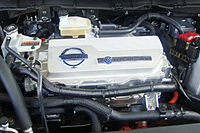
.jpg)
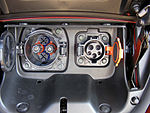
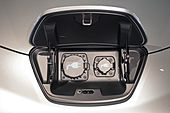
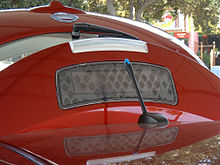

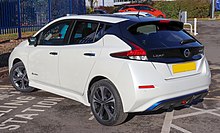
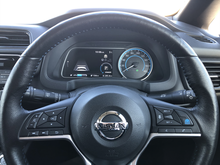
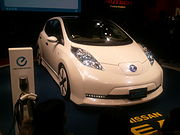
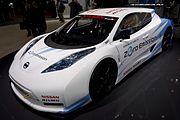
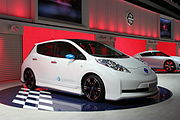

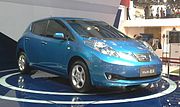
.jpg)
